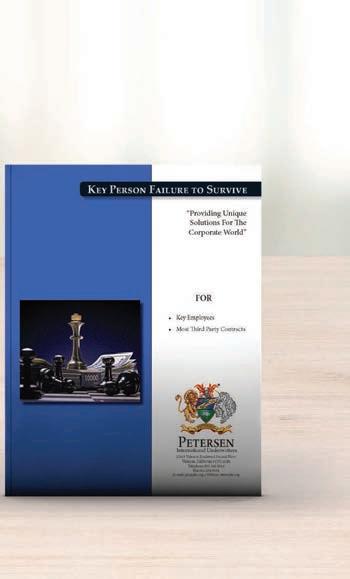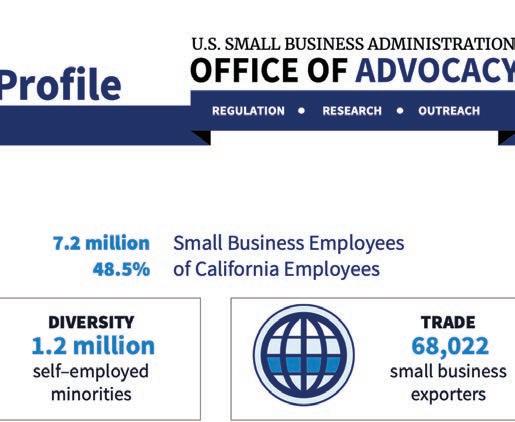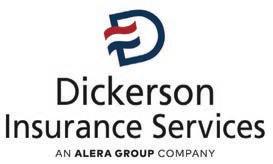


SMALL GROUP SURVEY / VIRTUAL MEETINGS / MEDICARE AEP NOVEMBER IS NATIONAL LONG-TERM CARE AWARENESS MONTH NOVEMBER IS NATIONAL LONG-TERM CARE AWARENESS MONTH SERVING CALIFORNIA’S ANNUITY, LIFE AND HEALTH INSURANCE PROFESSIONALS NOVEMBER 2022
San Diego and Imperial Kim Shields 951-323-5979 kshields@brighthealthcare.com
Riverside and San Bernardino Josie Cortez 714-642-3844 jcortez@brighthealthcare.com
Los Angeles and Orange Renee Szafirowski 562-477-3377 rszafirowski@brighthealthcare.com
Northern CA Sheri Hernandez 916-847-5227 sheri.hernandez@brighthealthcare.com
Korean Market Sam Han 626-825-8522 shan@brighthealthcare.com
English and Spanish Market Liset Tran 626-825-8456 ltran@brighthealthcare.com
Chinese Market Gary Chua 626-566-4321 gchua@brighthealthcare.com
Central Health Plan 1-626-388-2375 centralhealthplan.com/broker
Brand New Day 1-866-255-4795 Ext. 2018 bndhmo.com/brokers




David Milligan VP of CA Sales
Shaina Popkin AVP of Sales
It’s Not Too Late to Certify For the 2023 Medicare Annual Enrollment Period. 2023 Certification Training is now available. Contact our sales support sta to learn more.
CA







CA A California Different way to do health care. Quote Different | 800.542.4218 calchoice.com
TABLE of CONTENTS
14
MEDICARE
Medicare Marketing and Sales Updates for 2022 Open Enrollment, 2023 and Beyond!
Be aware of many changes and challenges this year
BY MARGARET STEDT
16
SMALL GROUP SURVEY
Small Businesses Account for 48.5% of California’s Workforce
Four industry experts share insights on covering these important Californians.
Hear from Dickerson, UnitedHealthCare, BenefitMall and Word and Brown
22
LONG-TERM CARE Relief For California Long-Term Care Partnership Policyholders
The passage of AB 2604 gives California long-term care insurance policyholders the ability to reduce and even eliminate rate increases under the California Partnership for Long-Term Care.
BY LOUIS H. BROWNSTONE
24
LONG-TERM CARE
2022 Marks the 21st Anniversary of Long-Term Care Awareness Month
Americans are living longer Let’s Celebrate While Planning for Future Healthcare Needs
This anniversary is notable because in these 21 years, less than 7% of adults in the U.S. have purchased Long-Term Care insurance (LTCI) coverage.
BY MARCIA ISRAEL
26
LONG-TERM CARE
2021
Extended Care Planning Using 1035 Exchanges
Ways to protect retirement plan assets from long-term care expenses using provisions of the Pension Protection Act of 2006
BY PATRICK JOHNSON
28
FIRST TIMERS
Young Adults Experience Health Insurance for the First Time Stories show how experienced agents and education are essential CalBroker staff asked two college student interns at a local agency to convey their experience with medical insurance and choosing plans, doctors etc.
BY KIANA RAYMONDO AND JUSTIN MORAN
31
LIFE SETTLEMENTS
Why Should Your Client Consider a Life Settlement? 10 reasons explained
BY LISA REHBURG
32
VIRTUAL MEETINGS
Streamline Your Business with Virtual Meetings
Find new ways to expand your reach, streamline your operations and provide more flexibility for your clients.
BY BRANDON HECKERT
34
EXIT PLANNING
Group Health Broker Ponders the Future
Find out what a fair payout is and how to transfer your clients to the right health insurance professional who will advocate for clients as you have for years
BY PHIL CALHOUN
36
ADVISING Developing the Coach Mindset
For sport or business, coaching is effective to win the “game”

Educating clients so they are armed with the information to make intelligent decisions with the idea of achieving better outcomes.
BY GLENN CRAWFORD
38
LEVEL FUNDING Understanding Level Funding and How to Guide Your Clients
With 10%+ rate increases, new options may appeal for companies looking to move from fully-insured health plans to self-funding.
BY TIFFANY STILLER
4 | CALIFORNIA BROKER NOVEMBER 2022CalBrokerMag.com JULY
2022NOVEMBER
SERVING
CALIFORNIA’S ANNUITY,
LIFE AND
HEALTH
INSURANCE PROFESSIONALS
EXTRA WHEN YOU


SMALL





Contact your local Covered California for Small Business sales representative to learn why we’re growing and how we can help build your business! An increasing number of agents and their clients are glad they did. EARN
SELL NEW
GROUPS Some Key Rules: 1. Applies to new to Covered California for Small Business (CCSB) groups with initial effective dates of 07/1/22, 08/1/22, 09/1/22, 10/1/22, 11/1/22, 12/1/22 and 1/1/23 2. Bonuses will be calculated on number of subscribers (employees) in e ect for the first e ective month of the policy as determined by CCSB. 3. No pro-ration of target values will take place. 4. Business written through partnering General Agencies qualifies. 5. Covered California intends to issue incentive payments forty-five (45) days following the ninety (90) day requirement outlined in Section D(1)(b) of Exhibit F. Covered California may modify its payment schedule at any time. For a complete list of the program rules go to: http://www.coveredca.com/agents/become-an-agent-for-small-business/CCSB-agents/ Earn even more for offering your clients California’s most comprehensive access to doctors and hospitals: Group Size (Enrolled Employees) Incentive Earned 51 - 100 $ 8,000 26 - 50 $ 4,000 16 - 25 $ 2,000 6 - 15 $ 1,000 Full Network PPOs* • Blue Shield • Health Net HMO offerings from* • Blue Shield • Kaiser Permanente • Sharp Health Plan NEW! CCSB offers 4-tier selection Single bill Covers enrollments across all CCSB Carriers CoveredCA.com/ForSmallBusiness 844.332.8384 a partnership that pays BONUS PROGRAM - COVERAGE EFFECTIVE: JULY 1, 2022 TO JANUARY 1, 2023 *Insurance companies by region and subject to change.
HealtH Broker
Hubbard
Randy Dunbar
Hunter
OPEN ENROLLMENT
Open enrollment: In person or online — create a better experience
Add online benefit fairs to your toolbox to meet the fluid dynamics of today’s workforce
BY LAURA KARES
HEALTH Five Reasons Why Your Clients Should Be Offering Fitness Programs Now
Getting workers to exercise postpandemic will make them healthier, happier with programs that offer multiple touchpoints that engage, re-engage, and reward members who work out consistently.
 BY RIK LEE AND LOURDY SOTO
BY RIK LEE AND LOURDY SOTO
44
BOOK REVIEW: CALBROKER PUBLISHER PICK
Walking to Destiny:
11 Actions An Owner MUST Take to Rapidly Grow Value & Unlock Wealth
From author Chris Snider BY PHIL CALHOUN
45 MEDICARE
Medicare Guidelines Alert
When Does Permission to Contact Medicare Beneficiaries Expire?
It’s important to understand what PTC is, who it covers and why it’s important for brokers to be in the know.
BY PATRICK RODRIGUEZ
OOPS: In the October print edition, Jessica Word of Word & Brown General Agency was listed incorrectly as president. She is in fact CEO.
6 | CALIFORNIA BROKER NOVEMBER 2022CalBrokerMag.com IN EVERY ISSUE Industry News 9 Ad Index 46 PUBLISHER
PuBlisHing,llC publisher@calbrokermag.com EDITOR Linda
Lalande editor@calbrokermag.com linda@calbrokermag.com ART DIRECTOR
Randy@calbrokermag.com VP MARKETING Devon
Devon@calbrokermag.com CIRCULATION calbrokermag@calbrokermag.com EDITORIAL AND PRODUCTION: editorialand ProduCtion Health Broker Publishing 14771 Plaza Drive Suite C Tustin, CA 92780 714-612-0306 calbrokermag@calbrokermag.com Subscriptions and advertising rates, U.S. one year: $100. Send change of address notification at least 20 days prior to effective date; include old/new address to: Health Broker Publishing 14771 Plaza Drive Suite C • Tustin, CA 92780 714-612-0306 California Broker (ISSN #0883-6159) is published monthly. Periodicals Postage Rates Paid at Burbank, CA and additional entry offices (USPS #744-450). POSTMASTER: Send address changes to California Broker, 14771 Plaza Drive Suite C • Tustin, CA 92780 ©2022 by Health Broker Publishing. All rights reserved. No part of this publication should be reproduced without consent of the publisher. No responsibility will be assumed for unsolicited editorial contributions. Manuscripts or other material to be returned should be accompanied by a self-addressed stamped envelope adequate to return the material. The publishers of this magazine do not assume responsibility for statements made by their advertisers or contributors. Printed and mailed by Southwest Offset Printing, Gardena, Calif. 40
42













































Failure to Survive Product Line With liberal underwriting standards and unique exibility, the Failure To Survive coverage provides a death bene t, and can accommodate impairedrisk cases that would typically be declined or postponed by traditional market carriers. • Contract Indemnity FTS • Key Person FTS • Buy/Sell FTS • Business Loan FTS (800) 345-8816 F www.piu.org F piu@piu.org Petersen International Underwriters FAILURE TO SURVIVE LOAN INDEMNITY CONTRACT INDEMNITY BUY/SELL INDEMNITY KEY PERSON INDEMNITY











INDUSTRY/NEWS
SEVEN WAYS TO IMPROVE YOUR RELATIONSHIPS WITH COWORKERS

There’s been a cost to COVID-related social distancing and the rise of remote work: a loss of social connection with our colleagues and coworkers.
The power of “micromoments”
First, it’s important to understand what drives social connection. While that sense of togetherness can come through extensive time together or grand gestures, research shows it is more often built through a series of “micromoments” that occur over time.
Create opportunities for connection in your meetings. Whether in-person or online, kick off meeting agendas with a few minutes of a good connecting exercise. Some examples:
Check-in questions: These can be a fun way to learn about your colleagues. If it’s a small team, start with a quick check-in question around the table: “What was your first job?,” “What is your non-work-related superpower?,” or any of hundreds of others that can be found on the web. If it’s a bigger team, have everyone pair off to share their answers.
Focus on the positive: In his book, “Are You Fully Charged?” Gallup senior scientist Tom Rath says that
3 Ways Data Helps Telehealth Companies Meet Growing Demand
The use of online healthcare services has grown to 38x higher than pre-pandemic use, according to a new study by Sales Force. By combining the right telehealth team with the right data, companies avoid trouble. Read more. https://bit.ly/3T9hHfp
we should aim for 80% of our interaction time to be positive at work — talking about successes and strengths — and only 20% for areas for improvement or difficult conversations. These positive exchanges increase “our ability to communicate, collaborate and trust others.”
As COVID-19 guidelines ease, we have the opportunity to rebuild important social connections with colleagues that were lost or put on hold during the pandemic. Reaching out and connecting can be difficult. Many of us are out of practice in the social game, and it can feel vulnerable to reach out or start the sharing. But so many people are feeling lonely and isolated right now; many of them will appreciate your efforts, even if they are a bit skeptical or confused at first. And it’s worth the effort. “Vibing” with others feels good, makes us happier, and helps us be more successful in our work.
Excerpted from greatergood.berkeley.edu
Read more: greatergood.berkeley.edu/article/item/seven_ways_ to_improve_your_relationships_with_coworkers#thank-influence
Four Ways to Help Your Coworkers Feel Respected
A lack of respect is driving people to quit their jobs. What can you as a colleague do to help?
Respect matters because it signals our worth as an employee and as a person. Feeling disrespected at work is now a leading reason that U.S. employees are quitting their jobs, according to the Pew Research Center, following only low pay and lack of opportunity for advancement.
Researchers have studied the notion of “cadence” in work relationships, and it is helpful to think about respect in terms of a foundation of repeated respectful interactions. This suggests that being clear with how you want to be valued, and regularly valuing others in ways that they want to be valued, are crucial.
Read more: greatergood.berkeley.edu/article/item/four_ways_ to_help_your_coworkers_feel_respected
NOVEMBER 2022 CALIFORNIA BROKER | 9CalBrokerMag.com
CURATED NEWS FROM THE INDUSTRY
Small moments of listening, sharing and being present can make us feel more connected at work
Where there’s numbers, there’s answers
INDUSTRY/NEWS
Study: Video telehealth, in-person diagnoses agree in 87% of cases

Specialty care was significantly more likely to result in concordant diagnoses between telehealth and in-person appointments, compared with primary care. Diagnoses from preliminary telehealth consultations matched in-person visits in 86.9% of cases, according to a study published in JAMA Network Open. Dive deeper: https://bit.ly/3VfqpuC
Nov. 10, 10:00 - 11:00 AM PST
NAHU Professional Employer Organizations (PEO) and what makes a PEO Broker Friendly, Sponsored by JustWorks. Register: https://bit.ly/3VBc7Vq
Nov. 13-16, HLTH 2022 Health Innovation Expo, Las Vegas. Register: hlth.com/2022event/register
Dec. 1, 8:30 am EST EBRI 2022 Retirement Summit, Washington D.C. Online & in person. Register: ebri.org
Dec. 1, 11:30 – 1:30 pm PST
WIFS: Tax Year In Review and What’s Coming in 2023, Contact Janet Fishman:janet@wifs-losangeles.org
Dec. 19-21, Money 2.0 Conference, White Wing CEO Joshua Schneeloch will present along with other experts. Las Vegas. Details: money2conf.com
Jan. 24, 2023 10:00 AM to 1:00 PM PST,
NAHU Live Virtual Corporate Wellness Certification. Register: https://bit.ly/3EPmWx9
March 13-15, 2023, Ellevate Women’s Leadership 2023 Summit, Las Vegas. Register: https://bit.ly/3TdN8FN
Questions to Ask Your Employees Once a Month If You Want Them to Stick Around
Don’t underestimate the power of regular one-on-ones with employees, a pair of CEOs remind leaders. So what should you be asking your people when you corral them for that monthly check-in? Here’s a sample:
1. In the past few months, when have you felt most motivated or energized in your work (if at all)?
2. Is it clear why the work you do matters to the organization?
3. Which of your skills do you feel is not being used in your current role?
4. Is there any part of the team you wish you could interact with more?
5. How do you feel about the current level of social interaction across the team?
6. How do you prefer to be recognized for work well done?
7. Is there any aspect of the organization that you wish you knew more about?
8. What’s felt confusing or frustrating for you lately?
9. To what degree would you say the vision of the organization is clear?
Dig deeper here: inc.com/jessicastillman/employee-retention-greatresignation-on-on-one-meetings. html
10 | CALIFORNIA BROKER NOVEMBER 2022CalBrokerMag.com
How Digital Tools Promote Patient-Centered Care
More high-tech advances for better care
Using digital health tools to identify patients with symptoms of depression and make it easier for them to actively seek care is one of the projects highlighted in the 2021 annual report from AHRQ’s Digital Healthcare Research Program.
The report describes 21 completed and 25 ongoing AHRQ-funded research projects, including interventions that use digital healthcare tools to bring care to patients outside of traditional healthcare settings. The report also highlights emerging research that focuses on AHRQ’s priority areas, including the role of social determinants of health.
The report and the new blog AHRQ Views blog are available now.
•ahrq.gov/news/blog/ahrqviews/ patient-centered-care-dhr.html
•digital.ahrq.gov/programoverview/research-reports/2021year-review
Racially biased medical device results raise patient safety concerns
Racial biases continue to be exposed in the medical devices that physicians commonly use to evaluate patients. From thermometers to oximeters to X-rays, people of color receive the most inconsistent results, which is detrimental to their health.
Health systems are attempting to remove these biases to enhance quality and eliminate health disparities. Many are still in the process of identifying where inequalities, processes and devices need to be evaluated further. The Food and Drug Administration is starting to take action, too.
•Read more here: https://bit. ly/3T5Ub2Q
•And here: https://www. americanscientist.org/article/ suffocating-from-medical-bias
Where does your health care dollar go?

Americans deserve to know how their premium dollars are used. To provide that insight, AHIP has updated its Health Care Dollar, analyzing 3 years of data — from 2018-2020 — of where premium dollars are spent in the commercial market (employer-provided coverage and individual market). The analysis shows that 82.4 cents of every premium dollar go to prescription drugs and medical services — up from 81.6 cents from its last analysis released in 2020.
“Your premium—how much you pay for your health insurance coverage each month—helps cover the costs of the medications and care you receive and improves health care affordability, access and quality for everyone. Here is where your health care dollar really goes.”
Quickly respond to your clients’ needs
We are here when you and your clients need us most. Our providers care for our patients with healthcare resources that extend beyond the doctor’s visit.
Our online Broker Portal helps you access important information and resources so that you can respond quickly to the needs of your clients.
The portal provides quick access to find PCPs, urgent care centers and hospitals, entire network of specialists, and more.
For more information and to sign up, please visit our dedicated broker portal at brokers.regalmed.com
NOVEMBER 2022 CALIFORNIA BROKER | 11CalBrokerMag.com FASTEST, EASIEST, MOST TRUSTED. BenefitMall.com 800.350.0500
RegalMed.com | LakesideMed.com | ADOC.us 22RLANSMR412EN02
Full
INDUSTRY/NEWS
Reimagine Financial Wellness Benefits

The signs are clear. Employees want to see more modern benefits geared towards their financial wellness goals, and employers who provide those benefits will better attract and retain talent.
Read more at benefitnews.com
What Has (and Hasn’t) Changed About Being a Chief Diversity Officer
Chief Diversity Officers (CDOs) consistently report that their organizations began viewing DEI as much more important after the summer of 2020. [However,] this growing interest was not generally accompanied by the resources needed to perform all this additional work. [This study concluded that] organizations must empower CDOs to drive long-term change by investing substantial time and resources into DEI. Leaders need to be held accountable for aligning their overall business strategies with the guidelines they give their DEI teams; executives from every function [need] to work together with CDOs to craft strategies that link organizational success metrics with DEI goals; [and organizations need to] prioritize helping DEI leaders cope with the personal and professional burnout that can often come with the job.
Read more: Harvard Business Review https://hbr.org/ and https://bit.ly/3D1XXoS


Generation Broker
of everything that holds
More of
Digital Technology The Human Factor+ BenefitMall.com |


©2022 BenefitMall. All

12 | CALIFORNIA BROKER NOVEMBER 2022CalBrokerMag.com
Next
Services. Less
you back.
everything that makes you great.
800.350.0500
rights reserved. BenefitMall, the BenefitMall Logos, and NEXT GENERATION BROKER SERVICES are trademarks or registered trademarks of Centerstone Insurance and Financial Services, Inc. d/b/a BenefitMall or its affiliates in the U.S. California License #0639679. Job Seekers in California See Pay Transparency Under New Law Advise your clients to be prepared California job hunters will no longer have to take a shot in the dark when asked about their salary expectations. Gov. Gavin Newsom (D) signed a new law in effect requiring California companies with 15 or more employees to post job salary ranges, starting Jan. 1 of next year. The state’s pay transparency law aims to help alleviate sex-based wage disparities by establishing a level field for pay practices.
article here: https://bit.ly/3rWFX96
California Workers Gain New Cannabis Protections: What Employers Need to Know
A new protection is on the way for employees in California who use cannabis before or after completing their workday. Governor Gavin Newsom signed a bill yesterday expanding employment discrimination protections under state law to also cover an employee’s off-the-job cannabis use. AB 2188 greatly expands cannabis users’ rights to fight discrimination in the workplace and prevents employers from firing workers or not hiring applicants just because of a positive cannabis test. While the new law does not go into effect until Jan. 1, 2024, California employers will want to use the next 15 months to make sure you are in compliance.
What do you need to know about this significant new development? Importantly, AB 2188 will not take away an employer’s right to maintain a drug-free workplace. You can continue to issue disciplinary actions against employees who possess or use cannabis on the clock.
How should employers prepare for AB 2188 Cannabis Protection bill?


To prepare for AB 2188, review your current processes for drug testing to determine if they are compliant under the proposed legislation. If current testing methods rely on the finding of non-psychoactive cannabis metabolites, then you should research and consider alternative testing methods.

Additionally, review your current policies on drug and alcohol use to ensure that they comply with AB 2188. While AB 2188 does not allow employees to be “impaired” while at work, it does complicate the ability of employers to determine if an employee is impaired while working.
Dive deeper: www.fisherphillips.com


NOVEMBER 2022 CALIFORNIA BROKER | 13CalBrokerMag.com
Medicare Marketing and Sales Updates for 2022 Open Enrollment, 2023 and Beyond!
BY MARGARET STEDT
For all of those who sell, offer products and provide services in the Medicare arena, this year has brought the most changes and challenges that we have seen in this market for many years. Thanks to the Inflation Reduction Act (IRA) signed by President Biden on Aug. 16, 2022, there are many changes to Medicare, Medicare Marketing and Sales Regulations and in the Dual Eligible Special Needs Plan.
Everyone is scrambling to make sure they are selling and servicing compliantly, determining the plans to offer and being “ready to sell.” These changes are not only changing how we do business but also affects the bottom line of our business in both hard and soft dollar costs — with a short period of time for learning curves and implementation.
The IRA is the beginning of the implementation of many years of substantial changes to the Medicare Part B and Part D plans (Stand-alone and Medicare Advantage Plans.)
Changes will begin this year and will continue through 2030 and include the following:
2022: Health and Human Services (HHS) is authorized to begin negotiations of the prices of 10 high-cost prescription drugs. The new negotiated prices go into effect in 2026. Note that the number of drugs that will be negotiated will increase to 15 in 2027 and 2028 and then go to 20 in 2029 and every year thereafter.
2023: Good news for applying for “Extra Help.” The income threshold to qualify for a subsidy to help pay for the Part D out-of-pocket costs will be increased from 135% of the federal poverty level (it was $18,347 in 2022) to 150% (was $20,385 for an individual in 2022).
Insulin: Any insulins that are covered by the plans will be capped at $35 in all phases. That means the covered individual will not pay more than $35 for a one-month supply of each insulin product covered even if they have not met their
deductible. If the cost-share for the tier the insulin is on is less than $35, they will pay the tier cost-share (the lesser amount). A number of plans will continue to offer the Senior Savings Insulin Saving Program for select insulins. Please always check to see which plans offer this benefit.
Vaccines: Most vaccines will be free for Medicare enrollees beginning in 2023. Vaccines such as Shingrex for shingles that are covered under the plans will be $0 copay even if the individual hasn’t met their deductible and in the Initial, Gap and Catastrophic phases. Note this applies to any vaccine that is on the CDC Immunization Recommendation List for Adults (over age 18) that is covered by the plan. There may be a separate vaccine administration fee at some pharmacies. Not all pharmacies provide and/or administer vaccines. Please always check the plan benefits and formularies.
2025: The total annual out-of-pocket spending on prescription drugs under Medicare (for stand-alone plans or Medicare Advantage plans) will be capped starting in 2025 at $2,000.
Some additional provisions apply to the Part D premiums:
The premiums for Medicare Part D plans will not increase more than 6% a year through 2029.
Beginning in October 2022, if the price of a Part D prescription drug is raised more than the rate of general inflation, the drug manufacturer will have to rebate Medicare the amount of the increase that is higher than the inflation rate.
The Secretary of HHS will be authorized to make a one time adjustment to the Part D premium percentage in 2030.
Special Needs Dual Eligible Plan (D-SNP) Change
CMS is not renewing “look alike” D-SNP (Special Needs Plans for Dual Eligibles) for next year nationwide. Instead, CMS has asked all health plans to transition current “look alike” members into a Medicare Advantage Prescription Drug
14 | CALIFORNIA BROKER NOVEMBER 2022CalBrokerMag.com MEDICARE
Be aware of many changes and challenges this year
Plan (MAPD) plan that has a projected enrollment of less than 80% of dual-eligible individuals. Each carrier is providing information regarding which plans will be available for agents to market and to which plans by county the Dual Eligibles will be mapped to or disenrolled from. Contact your carrier representative for more information regarding the plans and the mapping.
CMS Marketing Rules Changes as of Oct. 1, 2022
By far the biggest challenge this year is the new Medicare Marketing Rules that affect agents, carriers and third party marketing organizations (TPMO). CMS views agents as included in the definition of a TPMO. Because of so many complaints about misleading benefit information (over 40,000) received by CMS, they decided on a broad stroke basis to require all agents follow the TPMO rules requiring a recording of all calls that relate to marketing i.e., sales and servicing of Medicare Advantage and Prescription Drug plans. This includes scheduling of appointments and other discussion of benefits.
If an individual refuses to be recorded, we must end the call. However, you may continue the discussion by email or meet in person.
In addition, CMS has required that agents add the following disclaimers to all marketing materials including our emails and text messages:
“We do not offer every plan available in your area. Any information we provide is limited to those plans we do offer in your area. Please contact Medicare.gov or 1-800-MEDICARE to get information on all of your options.”
To add to the difficulty of finding and implementing a new call recording system and learning to use it effectively, carriers are not all in agreement with the interpretation of the marketing rules. Are carriers required to record or not record zoom calls? Or can they continue the call if the Medicare beneficiary refuses to be recorded? Check with your carriers for their requirements but make sure to follow the CMS rules!
The National Assoc. of Health Underwriters (NAHU), National Association of Insurance and Financial Advisors (NAIFA) and the other agent organizations have requested clarification of the marketing rules from CMS. (The clarifications are pending approval and release as of the writing of this article.)
Please be aware that NAHU together with other agent organizations such as NAIFA have been meeting with and sending comments and formal letters to CMS trustees regarding the marketing rules. There was a formal request to delay implementation of the call recordings and to review the decision to include agents in the definition of the TPMO. Unfortunately, CMS is still holding fast to its decision. Other measures are being undertaken via letter campaigns to our federal legislators
to consider requests for legislative action.
I can speak for our community by saying we as agents feel strongly that we are being unfairly punished for the deeds of a few bad actors. These bad actors don’t seem to be held accountable by CMS and some carriers for their actions. CMS says they are cracking down, yet the misleading ads, unsolicited phone calls and bad behaviors continue!
This decision by CMS is leading many agents to reconsider being in the Medicare plan marketing space. This could lead to less agents being available to service the growing number of seniors and leaving the seniors to depend on the TPMO’s!
As a Medicare focused agent, I will follow the guidelines. I am thankful I have a Field Marketing Organization (FMO) that is providing me with the telephone recording technology and sales tools to meet those requirements, at no cost. I strongly urge you as agents to follow the guidelines — do not go rogue by not recording. I’m sure there would be unpleasant consequences.
For members of NAHU, information is being constantly updated in the member section for Medicare and with weekly updates. In a recent NAHU Washington Update, the organization noted:
“As the only trade organization representing professional agents and brokers who work with Medicare beneficiaries and Medicare products, NAHU is acutely aware of the far-reaching impacts this regulation will have on Medicare agents, their clients and the AEP. We will continue to update our Medicare Marketing Rule Resources page with any and all pertinent information that will assist you in complying with the rule.”
MAGGIE STEDT is an independent agent that has specialized in the Medicare market for the past 21 years. She is currently Medicare chair of Orange County Association of Health Underwriters (OCAHU) and past president. She served as immediate past president of California Association Health Underwriters (CAHU now CAHIP). Stedt also serves as an ad hoc member of NAHU (National Association of Health Underwriters) Medicare Advisory Group. Contact: maggiestedt@gmail.com

NOVEMBER 2022 CALIFORNIA BROKER | 15CalBrokerMag.com
Please add your voice to the cause by joining NAHU at nahu.org. Help us protect you, your clients and our future in this business. It is with more voices that we will be heard!
I strongly urge you as agents to follow the guidelines — do not go rogue by not recording. I’m sure there would be unpleasant consequences.
SMALL
Small Businesses Account for 48.5% of California’s Workforce
Four industry experts share insights on covering these important Californians
California small businesses are drivers of the state’s economic growth — creating two-thirds of new jobs and employing nearly half of all private sector employees. California is home to 4.1 million small businesses, representing 99.8 percent of all businesses in the state and employing 7.2 million workers in California, or 48.5 percent of the state’s total workforce. From 2018 to 2022 — 5,335 new small businesses were started.
The COVID-19 pandemic has presented a significant challenge to small businesses, employers and employees. An August Small Business Majority survey found that 44% of small businesses are at risk of shutting down. Data released through the Census Current Population Survey found that minority-owned businesses are disproportionately impacted: the number of active businesses owned by African-Americans dropped by 41%, Latinx by 32%, Asians by 25%, and immigrants by 36%.
Small business support is critical to ensure these Californians are connected to the resources they need to pivot and adapt to the COVID-19 marketplace. California Governor Newsom and the legislature are using every tool at their disposal to support small businesses as they work to safely reopen and recover from this public health crisis.
THE SMALL GROUP EXPERTS
CalBroker magazine (CB): What trends are you seeing for California Small Group? Is the market growing, or shrinking? Has the pandemic caused the closure of small businesses or is it the opposite?
Dickerson Insurance Services Sales Team
With Dickerson’s digital resources, we thrived during the shutdown — and helped brokers do well as a result. Although we saw businesses close, we also saw an uptick in newly formed businesses looking for employee benefits. Many businesses that didn’t offer benefits now provide coverage to their employees. Employers are starting to hire again. People are back to work, but there’s a lot of turnover.
Grant Snyder, VP, Small Group Sales, UnitedHealthcare, California
At UnitedHealthcare, membership is holding steady with exceptional group persistency and positive attrition for in-force groups. Early in the pandemic, California certainly experienced its share of increased closures of small businesses that were centered around certain industries (such as hospitality), but that has quickly corrected itself and now we are seeing positive growth in existing groups — a good sign for the business economy.
Another trend we are anticipating is the increase in membership due to the upcoming Medicaid redeterminations. Many people will move off of the Medicaid rosters and receive coverage through their employer, which will likely increase the small group market through positive attrition.
Hadley Weiler, Regional VP, Benefits West Region, BenefitMall
The answers can vary by California regions and industries. Overall, the California market is not shrinking, but growth and hiring has slowed down as a result of California employees leaving the state for remote work, general economic downturn, and inflation when compared to pre-pandemic years. At the height of the pandemic when many small businesses were closing, many businesses that kept employees on took advantage of the Employee Retention Tax Credit (ERTC) and are still taking advantage of the ERTC, showing a rebound in California Small Groups as a whole.
The market continues to be optimistic for innovative companies in Agtech, Fintech, Healthtech, artificial intelligence, blockchain technology and ESG (environmental, social and governance) companies. Venture capital investment funding remains at one of the all-time highs for startup companies, though it has dropped significantly in comparison to 2020/2021. However, money spent on payroll and benefits are less generous due to curtailed spending.
On the other hand, the late-stage startup companies that would have gone through IPO are not seeing as fast of a growth path as they used to, partly due to lesser investment funding.
16 | CALIFORNIA BROKER NOVEMBER 2022CalBrokerMag.com
GROUP EXPERT SURVEY
These companies are also seeing hiring freezes or even small labor force cuts. Even with an increased number of mergers and acquisitions of these late-stage startup companies, the capital/ finance is pooled to scale and grow more profitably with the hiring freezes.
Another trend California brokers are seeing is assisting their clients in setting up small business sponsored group plans outside of California to accompany a shift in the workforce where companies no longer have more than 51% of employees residing in California. Startup companies are increasingly turning to remote offices and hiring as a way of saving on overhead costs.
Employers are currently struggling to afford a higher payroll to keep pace with higher inflation rates. There is a need to adjust the cost of goods to offset the overhead and payroll in the consumer products industr.This will continue to be a tight balance for employers as consumer spending decreases over the next year. This could have adverse effects on small businesses’ willingness to add to staff.
“Although we saw businesses close, we also saw an uptick in newly formed businesses looking for employee benefits. Many businesses that didn’t offer benefits now provide coverage to their employees. Employers are starting to hire again. People are back to work, but there’s a lot of turnover.”
downsized, and that has certainly shaken things up for brokers and agencies. However, many brokers have seen increased opportunities because their clients’ businesses are growing. In a competitive talent marketplace, benefits can help employers differentiate themselves. We continue to look at ways we can help brokers write more and earn more by offering a broad range of products and services backed by outstanding sales, broker resources, broker tech, compliance, and customer client experience teams.
CB: Has the pandemic increased access to ACA subsidies for small groups? Has this helped keep small groups covered?
Dickerson Insurance Services Sales Team
— Dickerson Insurance Services Sales Team

With the new ARPA subsidies and the impending “family glitch,” individuals and companies can take advantage of subsidies. They can keep the same benefit levels and reduce costs. We communicate this with all eligible clients, to help keep their employees happy, and save the business money.
Snyder, UnitedHealthcare
Lastly, California droughts and wildfires over the last few years have added to the struggle smaller, family-owned farms face following the pandemic. With lower crop yields and rising food costs, these farms will have to look for innovative ways to keep their doors open.
Marc McGinnis, president, Word & Brown General Agency
We continue to see growth for most brokers with whom we are working. Yes, some businesses have closed, and others have
Employers definitely took advantage of available subsidies and/or loans, and those opportunities certainly made a difference in helping to keep many small businesses going. I think we’ve returned to a “new normal” scenario where businesses can focus again on growing as opposed to just surviving.


Weiler, BenefitMall
From what we have seen, the pandemic has not made much of an impact on access to ACA subsidies for small groups.
Typically, technology companies pay higher wages to attract and retain qualified employees, so these groups would not
NOVEMBER 2022 CALIFORNIA BROKER | 17CalBrokerMag.com
qualify for Small Business Health Care Tax credits, which are only available through the CoveredCA Small Business SHOP plan — even with the economic downturn. The California SF Bay Area minimum wage has traditionally been above the California minimum wage threshold as well, so it is very rare for these small employers to qualify.
On the other hand, small employers that do qualify may not even realize that they have health care tax credits until their certified insurance agents inform them of their eligibility. Even once informed, we sometimes see employers electing MediCal (CA Medicaid) benefits instead, so they do not pay for their cost share towards the group sponsored insurance benefits.
If a small employer has already taken the tax credit for two consecutive tax years, they are no longer eligible for the Small Business Health Care Tax Credit. Therefore, this is not a long-term solution for small groups.
McGinnis, Word & Brown
deductible plan and shift the responsibility to the workers. More employers are looking into alternative funding to help lower their costs. Businesses are also looking for cost-effective measures to keep their doors open.
Another trend we are anticipating is the increase in membership due to the upcoming Medicaid redeterminations. Many people will move off of the Medicaid rosters and receive coverage through their employer, which will likely increase the small group market through positive attrition.
 — Grant Snyder, VP, Small Group Sales, UnitedHealthcare, California
— Grant Snyder, VP, Small Group Sales, UnitedHealthcare, California
Affordable Care Act (ACA) subsidies are available only to individuals and families who purchase coverage through a public exchange, so they have minimal effect on small businesses. If an employer does not offer group coverage and, instead, steers workers to the exchange to purchase coverage on their own, some employees could benefit from expanded subsidies. What really helps groups shop for the best value on group health and other coverage is working with a broker who can thoroughly shop the market. Our proprietary quoting technology delivers side-by-side comparisons with highlighted plan differences. Our provider and Rx searches ensure clients get access to their preferred providers in the plans they’re considering. A benefit for employers in providing employee benefits is the ability to reduce taxes and take a tax deduction for the expense.
CB: How has inflation affected small businesses in terms of keeping workers insured? Do you have special offerings to help? Are you seeing adjustments in benefits packages?
Dickerson Insurance Services Team
Employers are looking for ways to cut insurance costs. Most employers will offer to pay 50% of the lowest cost, high
Dickerson and our broker partners are continuing to provide lower-cost core benefit solutions coupled with ancillary benefits to supplement the out-of-pocket costs of the employees. These in-depth strategy discussions allow us to create a packaged solution that benefits the employee and the employer’s overall bottom line.
Snyder, UnitedHealthcare
Inflation is real and has a significant impact on everything we do. To date, we have not seen a huge increase in benefit buy-downs. We all know when small businesses have to pay more for goods and services, the ripple effect is higher prices for the end user and less consumer spending on discretionary items.
We’ve found innovative ways to support our clients and members. For instance, we partner with organizations like Peloton to help more people get or stay active and improve their overall well-being. As part of their health benefits, as many as 10 million UnitedHealthcare commercial members may be eligible for a yearlong subscription to the Peloton App membership — or a three-month waiver toward a Peloton All-Access membership – at no additional cost. Eligible UnitedHealthcare members in most states receive preferred pricing on select Peloton connected fitness products, including the Peloton Bike, Bike+ and Tread.
This summer UnitedHealthcare announced an important step in its continued efforts to make prescription drugs more affordable for people. We eliminated out-of-pocket costs for preferred short- and long-acting insulins, as well as the following preferred emergency use drugs that are critical in acute, life-saving circumstances. These include medications for severe allergic reactions (epinephrine), critically low blood sugar (glucagon), opioid overdoses (naloxone), and acute asthma attacks (albuterol). As early as Jan. 1, 2023, this will become a standard offering available to UnitedHealthcare fully insured clients with OptumRx new business plans and for existing plans upon renewal date.
18 | CALIFORNIA BROKER NOVEMBER 2022CalBrokerMag.com
Percent of Private Sector Establishments That Offer Health Insurance to Employees, by Firm Size Source: www.kff.org
Weiler, BenefitMall
Generally speaking, at the national level, inflation has affected small businesses because to keep cost down, businesses have reduced contribution levels. So in order to have a strong benefits package, employers are pursuing more specialty/nonmedical strategies and offering voluntary products like worksite, legal, pet and additional HSA/HDHP plan offerings.
That said, we do not expect California small employers to make major plan or contribution strategy changes in Q4 2022/ Q1 2023. California small group carriers filed their rates in May 2022, right before inflation hit, so Q4 medical renewals are still in single digits or low double digits. Q1 medical renewals are expected to be slightly higher, but not significant enough for small employers to make significant plan changes. Employers are also reluctant to reduce company-sponsored plans and contributions this year since it could cause employee dissatisfaction as their workload increases in light of hiring freezes or small labor force cuts.
benefits at a lower premium.


There is also an increased employer interest in offering employee assistance programs (EAP) and mental health wellness packages, which have become a hot topic during the pandemic. As inflation continues to impact the day-to-day lives of employees however, brokers are seeing more inquiries from small employers that want to purchase enhanced mental health/wellness benefits to assist their employees.
“Brokers are taking a more consultative approach in helping small employers now.To be successful, brokers need to know what additional products can keep the group’s benefits package robust, while keeping contributions manageable. They need to be more comprehensive with their benefit solutions and look to offer other lines either by partnership or acquisition.
... Brokers must also be willing to do their due diligence and embrace technology.”
— Hadley Weiler, Regional VP, Benefits West Region, BenefitMall
Small employers may consider downgrading the benefits at next year’s renewal if health insurance premiums continue to rise, or implementing level funding or HRA strategies to help curb employer costs. BenefitMall partners with a number of carriers that have level funding offerings for small employers in California. Typically, this is a strategy for 25+ life groups where employers with good risk scores could see potential savings by using level funding plans.
Small startup companies that receive investment funding will continue with fully insured strategies, but employers are more prudent with their employee benefits spending these days. For example, we are seeing small employers electing Gold/Silver tier plans as base coverage instead of Platinum/Gold plans. Small group HMO or narrow HMO networks will continue to serve as cost saving solutions as employers look to offer rich
In addition to virtual behavioral health services, some small group medical carriers are offering free employee assistance to medical members, while others partner with apps like Ginger or Talkspace to offer additional mental health wellness support as value-add services to small group employees.

Small businesses are also more willing to look at alternative funding solutions. While ICHRAs can be a solution for some small employers looking to save premium, we’re not seeing huge traction in the California market since the individual health medical carriers do not offer broad network plan options. For small employers that are looking to attract and retain employees, this is not a popular solution since it is more difficult to administer versus a small group employer sponsored plan.
McGinnis, Word & Brown
Businesses are seeing higher premium increases than in the past few years. The pandemic reduced costs for insurers as utilization was lower. Now, utilization is up as individuals and families catch up on some of the medical care postponed during the past two years. Employees are looking for different benefits today. In response, employers are expanding offerings, giving employees more of a say in their benefits. It’s not really driven by inflation, but by changing needs and demands from employees. Our approach is – and always has been – to work
NOVEMBER 2022 CALIFORNIA BROKER | 19CalBrokerMag.com
with brokers to help them find the right balance to satisfy employees’ needs and wants, while still helping employers control their costs.
CB: What are the keys to being a successful broker to small groups right now?
Dickerson Insurance Services Sales Team
Go above and beyond and bring something new to the table other than the traditional HMO/PPO plans. Offer other lines of coverage such as ancillary products. Stay in contact with your clients often. Communication, collaboration and accountability are key! Being able to offer everything to a client is crucial. Dickerson has the right connections and contracts to do that. We communicate strategies effectively with the client, make good on promises, and ensure that we administer the client’s accounts diligently.
Snyder, UnitedHealthcare
robust, while keeping contributions manageable. They need to be more comprehensive with their benefit solutions and look to offer other lines either by partnership or acquisition, such as property and casualty and workers compensation. The successful ones have partnerships with benefit administration technology, payroll, human resources, and compliance services so they can be a simple one-stop shop solution for employer groups.
Brokers must also be willing to do their due diligence and embrace technology. Know how to market your group, understand their current needs, look at all avenues of insurance from traditional, self and partial funding, etc. in this post-pandemic, remote work environment. Brokers must also be knowledgeable with carrier underwriting guidelines, contribution strategies, alternate funding solutions and compliance.
“What really helps groups shop for the best value on group health and other coverage is working with a broker who can thoroughly shop the market. Our proprietary quoting technology delivers side-by-side comparisons with highlighted plan differences. Our provider and Rx searches ensure clients get access to their preferred providers in the plans they’re considering.”

My most candid advice is to stay close to your customers as they need you more than ever. Don’t be afraid to share new product offerings, such as level funding, which can reduce overall premiums for small businesses with little downside risk. Do your homework in order to recognize and communicate the nuances between plans and the differences between carriers.
Weiler, BenefitMall
Brokers are taking a more consultative approach in helping small employers now. To be successful, brokers need to know what additional products can keep the group’s benefits package
Due to the Consolidated Appropriations Act, transparency in broker commissions also requires the successful broker to provide additional value-add services such as onboarding/offboarding tools and benefits booklets and enrollment videos to win agent of record and retain clients.
McGinnis, Word & Brown
A broad portfolio and service are key. Employers are expecting more from their benefits brokers, and it is important brokers have a reliable partner to help them address changing needs and ease their administrative burden. That includes offering products from multiple carriers, quoting and enrollment assistance, online forms and marketing tools, HR and benefits support for clients, answering compliance-related questions, and delivering value-added services clients will appreciate. As California’s leading independent general agency, we’ve been
20 | CALIFORNIA BROKER NOVEMBER 2022CalBrokerMag.com
— Marc McGinnis, president, Word & Brown General Agency
As shown in the chart, six health insurance companies accounted for 96% of the enrollment in small group health insurance plans in California. Source: Healthcare.com
partnering with brokers for decades to help them be more successful.
CB: What does the future look like for small group health?

Dickerson Insurance Services Sales Team


We’re seeing a shift to more remote positions. The location of the employee, in many cases, is irrelevant. Companies have employees scattered across the country, so the future of small group health will revolve around more creative benefit offerings that can accommodate the entirety of the workforce. Dickerson’s prepared for these changes, as we’ve been creating solutions like this for years.
Snyder, UnitedHealthcare
For UnitedHealthcare in California, small group health is a focus — it’s what we do and we do it well. We see a huge upside for our health plan in continuing our commitment to small business, and our partnership with our clients to provide improved operational efficiencies, a wide variety of product offerings, and exceptional service for our members. Our mission is to help people live healthier lives and make the healthcare system work better for everyone.
UnitedHealthcare is not just a local state-based plan; it has the strength of a Fortune 5 enterprise connected across all aspects of the healthcare delivery system and ready to help transform it. We’re exceptionally positioned to pivot and change, as needed, and are ready to help small businesses in California flourish.

Weiler, BenefitMall
The future is bright for small group health. This is not the first time brokers have had to weather economic downturns, and with economic changes come opportunities. Employee benefits will continue to play an essential role for small businesses as they seek to hire and retain quality staff, regardless of industries. The challenge will be in expanding benefits packages without increasing contributions for employers. Small group health is strong, but agent competition is fierce, especially with broker acquisition. We see plenty of opportunities for small brokers and mid-level shops.
On the startup front, venture capital firms continue to search for their next unicorn. U.S. and foreign investors are still cautiously optimistic about the next great innovation. However, we may not see as many startups in California compared to other states, as they can offer attractive business tax incentives, while the cost of living in California continues to increase — it’s becoming more expensive for employers to operate their small business in the state.
Overall, the future outlook is optimistic, but brokers will have to design benefits packages that include emotional and financial wellness to support both small business employers and employees while keeping the health care costs affordable and attractive. There are increasingly competitive, unique funding offerings available in the marketplace, as well as investments in technology to fuel speed, growth and trusted data integrity. The key for many brokers will be to work with a trusted General Agency partner to offer robust benefits offerings, backed by digital enrollment and benefits administration, in order to take advantage of near-term and long-term growth opportunities.
McGinnis, Word & Brown
We believe the future is bright for Small Group Health and for brokers. California has more than 4.1 million small businesses that represent more than 99% of all businesses in the state. Small businesses drive nearly half (48.5%) of the private workforce in the state, and they have been a driving force in America’s recovery from COVID-19. The Census Bureau says net job growth is strongest among businesses with fewer than 20 employees. The past two years have been challenging, but according to a recent survey, fewer than a quarter of small businesses furloughed or laid-off employees. We continue to grow, and we are committed to helping brokers adapt and grow their businesses as we all work to address the changing needs of employers and employees.
MEET THE PARTICIPANTS:
Contact: dickerson-group.com
NOVEMBER 2022 CALIFORNIA BROKER | 21CalBrokerMag.com
DICKERSON INSURANCE Services Sales Team, an Alera Group Company.
GRANT SNYDER, Vice President, Small Group Sales, UnitedHealthcare, California Contact: uhc.com
HADLEY WEILER, Regional VP, Benefits West Region, BenefitMall. Contact: benefitmall.com
MARC MCGINNIS, president, Word & Brown General Agency Contact: wordandbrown.com
RELIEF FOR CALIFORNIA LONG-TERM CARE PARTNERSHIP POLICYHOLDERS
BY LOUIS H. BROWNSTONE
By the time you read this, AB 2604 will have been passed by the California Legislature and signed by Governor Newsom. This will give California long-term care insurance policyholders under the California Partnership for Long-Term Care the ability to reduce and even eliminate rate increases.
The California Partnership for Long-Term Care, begun in 1994, was one of the original four partnership states. (There are now partnership plans in 44 states.) Its purpose was to provide long-term care protection for Californians with moderate income and assets. The program was designed to encourage public/private partnerships linking insurance carriers with California’s Medi-Cal program and allowing purchasers to protect assets from Medi-Cal spend down rules.
AB 2604 was originally proposed by Assemblywoman Lisa Calderon and supported and amended by a group of interested parties. It has been unopposed because of the obvious need to update partnership regulations.
The passage of AB 2604 will enable many thousands of partnership policyholders to retain their policies. For the vast majority, they can afford to lower their benefits and therefore their premiums and still keep significant benefits in their policies. They will not have to either cancel their policies or accept a non-forfeiture agreement after paying premiums for many years.
Among other consumer protection rules originally enacted, to ensure that policyholders would be able to afford this insurance, partnership rate increases were limited to a maximum of 40% over a three-year period. This rule has cushioned the
blow of rate increases under the partnership, but nevertheless, most policyholders now have had a rate increase of 50% or greater over their original premiums.
In addition, to ensure that the benefits would keep pace with inflation, partnership policyholders had to purchase 5% compound inflation riders. Insurance carriers have now priced 5% compound inflation riders so high in comparison with other inflation riders that no one would want to purchase a partnership policy. Sales have cratered.
To make sure that partnership policies would be robust, the nursing home daily benefit had to be a minimum of 70% of the average California semi-private nursing home benefit. This cost is now $360 per day, so that the minimum daily benefit is $260 per day, far more than the cost of most home care and all assisted living facilities. Most people today resist going into nursing homes until absolutely necessary, and prefer to receive care in other less expensive settings.
AB 2604 is designed to give policyholders options to reduce coverage and lower premiums but retain partnership certification. A policyholder can elect to reduce benefit levels to as little as $100 per day with a lifetime maximum of at least $73,000. In addition to 5% compound inflation, a policyholder can choose either 3% compound inflation or 5% simple inflation. These options can be exercised at any time.
22 | CALIFORNIA BROKER NOVEMBER 2022CalBrokerMag.com
LONG TERM CARE COVERAGE: COVER STORY
It’s difficult to predict the future of the partnership. It may be dependent on the result of the work of the California Task Force for Long-Term Care and whether its recommendations for a mandatory program become law.
Source: http://parseofpa.org/ themes/parse-theme/assets/docs/ LongTermCareInfo2017.pdf
Insurers who file for a rate increase must also allow policyholders to elect from a list of “available options,” which can include some or all of the following:
1.Reduce the daily benefit by 50%
2.Reduce the daily benefit by 25%
3.Reduce the benefit duration to the lowest duration on the insurer’s rate schedule, but not below 12 months
4.Reduce the benefit duration to the next highest duration on the insurer’s rate schedule, but not below 12 months
5.Increase the elimination period up to 90 days
6.Convert a policy to minimum coverage of $100 per day for a lifetime maximum of $73,000 (two years);
7.Reduce the inflation option to either 3% compound or 5% simple inflation. However, if a policyholder is 70 years old or older and has had a 50% or more rise in their original premium, they would also have a 1% inflation option.
The “available options” would be a part of any filing for a rate increase, and would have to be added to any pending rate increase filings. However, these options should not involve much time to add onto a filing. The rates should be easy for insurers to calculate except for either the 3% compound or 5% simple inflation riders, as for these, new rate tables would have to be created. However, all insurers have calculated at least one of these inflation tables in their non-partnership policies, and it should not be difficult to use these tables and their claims experience as guides.
Many partnership policyholders have benefited from the growth in their daily benefits because of the strength of the 5% compound inflation option, and now enjoy daily benefits of $300 or much more. They could still retain a very robust policy if they choose either 3% compound or 5% simple inflation. It’s hard to tell which option is the stronger one, as it takes 34 years for the benefit of 3% compound inflation to catch up with 5% simple inflation. I would think that for most policyholders,
who have aged since they purchased their plans, the 5% simple inflation option would yield a greater benefit.

For those who now have a daily benefit of $300 or more, a 40% or even 50% reduction in the daily benefit would still cover the cost of either an assisted living facility or up to five hours per day of a home health aide. Thus, there is plenty of flexibility for most policyholders to substantially reduce their premiums, either by the use of these new inflation riders, reducing their daily benefit, or a combination of both.
All of this having been said, it’s difficult to predict the future of the partnership. It may be dependent on the result of the work of the California Task Force for Long-Term Care and whether its recommendations for a mandatory program become law. If their work succeeds, I can envision carriers filing policies with wrap-around benefits under the partnership. That would be a win-win for California’s citizens.
LOUIS H. BROWNSTONE is chairman of California Long Term Care Insurance Services, Inc., a large specialist long-term care insurance brokerage, located in San Francisco.

Brownstone is currently a member of the executive committees of the National LTC Network and the National Alliance of Insurance Agencies. He is also active in NAIFA, the National Association of Insurance and Financial Advisors.
A graduate of Andover and Stanford, he has been a longterm care insurance specialist for over thirty years.
Contact: 650-231-4591 email: louis@cltcinsurance.com
NOVEMBER 2022 CALIFORNIA BROKER | 23CalBrokerMag.com
2022 Marks the 21st Anniversary of Long-Term Care Awareness Month
BY MARCIA ISRAEL
This anniversary is notable because in these 21 years, less than 7% of adults in the U.S. have purchased Long-Term Care insurance (LTCI) coverage. Most adults over age 50 have NOT planned for long term care or discussed it with their family. Healthcare brokers, financial planners, accountants, senior advisors and attorneys should be screaming from the rafters that creating a long-term care plan saves money, provides a guideline for the family in navigating care for the loved one, and determines the funding sources to pay for care.
Americans are living longer. Life expectancy in the U.S. has risen. By 2030, one in five residents in the U.S. will be age 65 or older, with 58% of women and 47% of men needing some form of extended care during their lifetimes.
Unfortunately, this isn’t something people plan for. Statistics show that most people do not understand the various forms of long-term care and the different ways to pay for it. Many do not plan for long-term care until a health care crisis hits them. Traditional and asset-based (hybrid) LTCI options are customizable to fit the needs and budget of each client.
When seniors do not plan for long term care, family and friends must scramble quickly to navigate the world of care options: placement, caregiving, insurance, benefits, paying for care. This includes taking out reverse mortgages, spending down savings, and/or tapping into retirement accounts, etc. to pay for care — leaving little or no funds for a surviving partner or for legacy.
It’s crucial to work with your clients to help them create a long-term care plan. Here’s why:
Currently, 14 million Americans need long-term services and support (LTSS); that number is expected to grow to 27 million by 2050. Single, older women comprise the majority who use these services.
Average out-of-pocket costs for personal care in California are $140,000 annually. Home care has reached $28-48 per hour; assisted living averages $5,000+ per month (with additional fees for personal care services). Board and care services begin at $2,500 and space is limited. The toll on family or friend caregivers is enormous and long-term care planning provides for caregiver respite.
By 2050, the number of Americans ages 65 or older living with Alzheimer’s disease and related dementias is expected to
double from about 6 million to nearly 13.8 million. (Source: Alz.org)
Two thirds of all new, individual long-term care insurance claims pay for care needed by women (NAIC 2019). The LTCI industry paid out over $11 billion in benefits to some 324,000+ individuals in 2019. Seventy percent of these claims were paid to policyholders ages 80 and over. Living a long life may mean a greater need for extended care in the future. (Sources: Mutual of Omaha; ASPE.HHS.gov)
Help your clients obtain coverage for their future extended care needs
Getting people to speak openly about this potentially sensitive subject is challenging. For many adults, LTC is an intangible, a “some-time down the road” need. Most people do not see it as a necessity in their everyday lives. Ultimately, when a loved one has no LTC plan, it’s the family members who are suddenly plunged headlong into the fragmented maze of private and public services, while trying to make immediate and critical decisions. Planning in advance for LTC creates peace of mind and protects the children, grandchildren, and friends.
Help your clients obtain coverage for their future extended care needs
As healthcare ambassadors, help facilitate clients’ planning now so that their eventual transition to custodial/personal care goes smoothly. With long-term care, the focus is on family, love and comfort, while also respecting the needs and wishes of the loved one.
Speaking with clients about long-term care planning
Conversation starters: Asking simple, open-ended questions offers insight into clients’ knowledge and provides a blueprint for their future LTC wishes. There may come a time when they may no longer be able to do that for themselves.
Who do you know who has needed custodial care? If they know someone who’s needed long-term care services, or they’ve been a caregiver themselves, they can better appreciate the emotional, physical and financial toll on the whole family.
What’s your plan for LTC? Most people plan to live a long life, but oftentimes they fail to consider what that means. As people age, they typically need personal care at some point. Discuss how their plan to live a long life could impact their
24 | CALIFORNIA BROKER NOVEMBER 2022CalBrokerMag.com
LONG TERM CARE
Americans are living longer: Let’s celebrate while planning for future healthcare needs
family. Ask about where they would prefer to receive their care — at home or in a community. Most prefer to remain in their own home.
How do you intend to pay for LTC? Medicare does NOT cover custodial/personal care, if that is the only care needed; it covers care in a certified skilled nursing facility (SNF) so long as that care is “medically necessary.” Medicare does cover all medical and therapy needs, but it is aimed at helping people get back on their feet after an illness or injury. It is short term. Ask if their plan for retirement includes paying for long-term care services out of their own pocket, or if they even qualify for Medi-Cal. Maybe their plan is to have friends and family help defray the costs. Ask if they have considered purchasing LTC insurance. If not, a final question might be to ask which assets they have ear-marked to pay for LTC. (Source: Medicare.gov.)
Who do you wish to be your caretaker(s)? If family/friends are designated as caregivers, has your client considered the physical, psycho-emotional, family, and financial onus placed on the caregiver? Caregiver burn-out places a tremendous stress on the family.
Anticipate common objections about LTC and LTC Insurance
Many of our clients have preconceived ideas about LTC. Help set the record straight by engaging in a meaningful conversation.
“What happens if I never need long-term care?”
No one believes they will need care as they get older, but we all age in varying ways. It’s estimated that over 70% of those ages 65 and over will need some form of long-term care services during their lifetime. It is protection for the family. No one can predict our future health needs.
“I can’t afford long-term care insurance”
When the numbers are crunched most people find they can’t afford not to insure and transfer at least part of the LTC risk to a carrier, especially when we consider the cost of 24/7 home care is at least $90,000+ a year and a nursing home costs nearly $112,000+ a year. On the other hand, the monthly cost of a policy can be affordable. (AALTCI). Prime ages for LTCI 48-68.
“I can self-insure”
That depends. Disposable income or assets of at least $225,000 per domestic partner may do the trick. Otherwise, a financial portfolio may be depleted in no time. Only 35% of Americans say they have set aside money to meet long term care needs.
It may not be worth risking a family legacy with the absence of planning ahead.
“What about Medi-Cal?”
Medi-Cal (Medicaid), a state- regulated and needs-based welfare program, comes with stringent requirements for qualification. It’s strictly meant for those who need government assistance. Medi-Cal (Medicaid) does cover the costs of nursing home care or care at home. The caveat with Medi-Cal

is that the number and availability of beds (and locations), the communities, and the quality of care is determined by the state. This should be the last resort when paying for long term care services,
Why aren’t advisors talking to clients more about LTC planning and LTC Insurance?
Advisors assume the clients are not going to spend as much in their late 70’s and into their 80’s. There is also the assumption that investments, savings, friends & family, mortgage loans, retirement funds, sale of life insurance, and liquidation of assets will be there to pay for LTC — but that is not always the case. Speak with clients about transferring that risk to long term care insurance insurers via Traditional or Asset-based (Hybrid) LTC Insurance
Why Long-Term Care Matters If You Sell Medicare and Healthcare Plans?
There is an enormous cost to waiting or to not planning at all; the numbers tell the story:
Percentage of Seniors ages 65 and over who have utilized LTC Services over the past 5-7 years:
• Adult day services center participants: 62.5%
• Home health agency patients: 81.9%
• Hospice patients: 94.6%
• Nursing home residents: 83.5%
• Residential care community residents: 93.4% (Source: CDC.gov)
To best serve our clients
As healthcare agents, we are the boots on the ground educating clients about the best coverages for healthcare, Medicare, LTCI, and ancillary or voluntary products. With the “graying” of America and the “Silver Tsunami” approaching, might we also consider guiding our clients and their families, (with input, of course, from their accounting, legal, and financial advisors), as they develop a comprehensive plan for future extended care needs?
MARCIA ISRAEL, MEd, VP of Stan Israel Insurance Services, Inc., is passionate to get the word out about the importance of Long Term Care Insurance and planning for a long term health event. Her goal is to educate the general public about the need, cost, and financing of Long Term Care. She offers free referrals for clients and seniors to help find placement with home care, assisted living, board and care, and free government services as well. Marcia, a Life and Disability Income agent for over 35 years, is a former educator in Los Angeles as well as a professional writer. Marcia and Stan are regular presenters for CAHIP, NAIFA, Fiduciary, and other financial, legal, and insurance industry associations.
Contact: 818-706-1100 Marcia@sdiins.com WWW.SDIINS.COM
NOVEMBER 2022 CALIFORNIA BROKER | 25CalBrokerMag.com
Extended Care Planning Using 1035 Exchanges
BY PATRICK JOHNSON
You can protect retirement plan assets from the financial risks of long-term care expenses and help preserve an estate for future generations. One of the ways to do this is by using provisions of the Pension Protection Act of 2006. The act allows the surrender of cash value from a non-qualified tax-deferred annuity to be used to pay a long-term care (LTC) premium and not be considered taxable income. The Internal Revenue Code Section 1035 allows the exchange of cash value from an existing annuity contract for a new LTC policy, without paying tax on the investment gains earned in the original contract. These transactions are often referred to as a “1035 Tax-Free Exchange.”
Some reasons to do a 1035 exchange is that the LTC policy provides tax-free benefits should the insured become benefit eligible. A new LTC policy could be better suited for current and future needs than an existing annuity contract that no longer meets the purpose for which it was originally intended.
Partial or full 1035 exchanges
Some annuity carriers allow what is called a “partial 1035” of cash value out of their contract. This could allow some flexibility in purchasing a new LTC policy. If the carrier does not allow a partial exchange then you have to do a full 1035 exchange and take all the surrender cash value.
When designing a plan of care, knowing the amount of the proceeds you have to work with will allow you to back into the various options for the client. This includes: the daily benefit amount, length in years for the benefit to last, elimination periods for assisted living and home care, and the inflation options.
Questions to Ask
As the client advisor, help them do their homework and ask the annuity carrier some important questions upfront in the planning stages.
•What is the current cash surrender value
•What are the surrender charges if any
•What is the policy anniversary date
•Do you allow a partial surrender?
Once you are armed with all the answers, you can back into
a proposal. Some pre-medical underwriting might be necessary before submitting the application. Issue ages can go up to 79 years of age.
New consumer features
Make sure your state allows a single premium into a traditional LTC policy like the National Guardian Life. This means that the coverage is guaranteed for life. No more premiums will be required. Another new option is called a lifetime benefit feature instead of the traditional 2, 3, 4 or 5 year benefit plan.
Call to action
Agents and brokers should review all their existing nonqualified annuity contracts and perform a due diligence review to see if moving the annuity to a LTC policy is in the best interest of the client. Also, in meeting new clients as you fact find their current assets always ask if they have any nonqualified annuities in their portfolio. You just may be pleasantly surprised.
Underwriting homework upfront
You have to qualify for long-term care coverage. That entails considering a client’s current age, health, medications and current medical treatments. Carriers have pre-submission tools that can help clients know if they should move forward with the application process.
Items that can disqualify an application could be height and weight, certain medications and conditions such as Alzheimer’s disease, dementia, congestive heart failure, type 1 diabetes, oxygen use and Parkinson’s — to name a few. All carriers provide agents with underwriting guides that list the conditions and medications. Other items that could make a client ineligible for coverage would be that they were previously declined for coverage, or that they currently require assistance with the activities of daily living, use a walker, wheelchair or are noncompliant with medications and treatments.
Some of today’s biggest medical concerns for the underwriters are depression, by-polar diagnosis, insulin dependence, diabetes, orthopedic problems, sleep apnea, cognitive dementia and memory loss, family history, obesity and circulatory issues and what are called co-morbid conditions
26 | CALIFORNIA BROKER NOVEMBER 2022CalBrokerMag.com
LONG TERM CARE COVERAGE
Ways to protect retirement plan assets from long-term care expenses
— having more than one major medical issue.
What care costs
The top reason one would buy a long-term care plan is to allow your loved ones to care about you instead of caring for you. Other reasons include to remain independent, to have a choice where to receive care, and to avoid burdening loved ones with caregiving roles. The cost for home care today in Sacramento, Calif. is around $28-32 dollars per hour. A one bedroom assisted living community starts around $5,000. A good source of information based on location is a website called ‘whatcarecosts.com.’
New for 2022
Besides paper applications, clients can now do an electronic application with their agent through I-GO/E-APP and do it all online. S0, start taking a look at all those non-qualified annuities and see if you can put those dollars to better use with a long-term care policy for your client.
Timely long-term care decisions suffer from denial of eventualities
Consider these recent findings from AARP:
• Someone turning age 65 in 2020 had a 70% chance of needing long-term care in their remaining years, according to the U.S. Department of Health and Human Services (HHS).
• The average person who needs help, at home or elsewhere, needs it for three years, but 20% need it for at least five years, HHS says. About onethird need nursing home care for an average of 1 year.
• The cost of such care varies widely across the United States. In 2021, the median monthly cost was $5,148 for a home health aide, $4,500 for an assisted living facility and $9,034 for a private room in a nursing home, according to a survey by Genworth.
• Despite those needs, just 18% of adults over 40 have looked into longterm care planning for themselves; a third have helped an older family member get information, says an AARP survey conducted in 2020.
Turning Denial Into Action
Ready to start a conversation about long-term care, for yourself or a family member, but don’t know where to start?
You can learn the basics, about services, how to pay for them and how to prepare, at the U.S. government’s LongTermCare.gov website. The site includes tips for anyone, healthy or not, over age 50.
PATRICK ‘PJ’
JOHNSON is an independent life insurance agent and also does sales and marketing for CPS Sacramento. PJ has been a NAIFA member since 1984 and a past board member of the Greater East Bay chapter and past board member of the Sacramento FPA association. He has a CLU and a CLTC designations.

Contact: pj@cpssac.com 925-200-9482
But navigating the emotional terrain of these conversations can be tricky. A few expert tips:
If talking with a reluctant family member, focus on your love and concern, says life care planner Jennifer Crowley: Say that “it would mean a lot if you could just kind of look ahead at some of these things that are worrying you.”
If a loved one still doesn’t want to talk? Ask yourself, “Am I the best person to be having this conversation?” suggests eldercare consultant Joy Loverde. Sometimes, a professional life planner, a trusted doctor or a social worker can help.
Listen to your loved one and respect their choices, even if you don’t agree, Crowley says. If you can make just a little headway, she says, focus on “the basics” — such as essential legal documents that say who will make health and financial decisions if the person becomes incapacitated.
Excerpted from AARP: “When Denial Gets in the Way of Long-Term Care Planning”
A common refrain: If we don’t talk about it, it won’t happen
By Kim Painter, AARP
https://www.aarp.org/caregiving/financial-legal/info-2022/avoiding-longterm-care-planning.html
NOVEMBER 2022 CALIFORNIA BROKER | 27CalBrokerMag.com
Young Adults Experience Health Insurance for the First Time
HOW EXPERIENCED
AND EDUCATION ARE ESSENTIAL
CalBroker
staff asked two college student interns at a local agency to convey their experience with medical insurance and choosing plans, doctors etc. Brokers have likely heard similar stories from young adults. The experiences they share are a clear reminder how much education is required to navigate our complex health insurance world and why health insurance professionals play a critical role as client advocates. The value of the assistance agents can provide to help select a plan and medical providers and then understand coverage and access to tests and treatment is vital to successfully navigate the healthcare system.
was aware of the ins and outs of Covered California. So, my first step was to apply for their coverage. Based on my income, I was moved into the MediCal path where I had to pick a health care insurer through CalOptima in Orange County.
My next step was to go to CalOptima’s website where I created my profile. However, when I wanted to select a physician I was required to fill out and mail-in a paper form to the Orange County Health Department. That form listed all the insurance provider groups I could choose from. I followed the directions on the form, selected HPNRegal Medical Group, and mailed it in. Next step was to pick a doctor within Regal medical group. After some research I discovered I had to go back online to CalOptima to actually choose my doctor.
Another step!
Luckily the CalOptima website has a provider directory and I was able to filter my health care needs and options in order to see possible primary care doctor options. The online portal had city and radius options and the specialty I needed for primary care. Filling out the filter then took me to a new page with a list of doctors that met my criteria. Finally, I was able to select a doctor and call the office and make an initial appointment.
to stay in-network if I want any of my medical bills covered. I learned the hard way when trying unsuccessfully to find urgent care and then ended up going to the emergency room. Since I stayed innetwork for the ER, CalOptima and HPNRegal coverage covered all the costs — so fortunately I left without paying a cent.
I am still learning more about my coverage. I do not have any upfront costs or co-pays so it seems Medi-Cal will cover everything I need. I also know it is tricky if I get injured outside of Orange County. It seems I must pay out-of-pocket as I am not covered anywhere else in California. If I move back to Fresno County I would have to reapply for insurance through the new county.
Editor’s Note: Kiana had to go through many steps to successfully obtain coverage and an assigned doctor. The health insurance maze is confusing and many people come to learn the value of the advice provided by health insurance professionals. Several health insurance professionals we spoke with refer clients to MediCal and do not have the capacity to enroll clients. The website to send clients to is dhcs.ca.gov/services/medi-cal/Pages/ ApplyforMedi-Cal.aspx
After my dad retired in 2020, I was faced with finding my own insurance. Thankfully, my dad had worked for Fresno County Social Services and he
But wait — on the call I was informed the doctor would need to contact my insurance to confirm I was a patient and was assigned to them through CalOptima. What came next was ANOTHER series of patient portal decisions and data entry.
In-network coverage is vital to understand
I also now know how important it is
Justin Moran, California State University, Fullerton college student, shares what he discovered about picking a health plan
College students often don’t consider or worry about health insurance because most of us young people think we are invincible. Understanding which health insurance plans are the best fit is challenging. There are many medical services and coverages to consider. Two

28 | CALIFORNIA BROKER NOVEMBER 2022CalBrokerMag.com
Kiana Raymondo, California State University, Fullerton college student, shares her research to enroll with MediCal.
FIRST TIMERS
STORIES SHOW
AGENTS
common needs are how to get a basic checkup or when ill or injured, when you should go to the emergency room.
Picking a health insurance plan
Here’s what I found out a person needs to know to make an informed choice, starting with Covered California Affordable Care Act (ACA) marketplace: First, you need to have a good understanding of the four health plan categories — Bronze, Silver, Gold and Platinum — which vary on cost and coverage.

Premium costs vary based on the coverage the plan offers, with expensive plans covering more costs. The cost of medical care is split between the health plan and the patient. I learned that the quality of care is separate from the premium paid for the plan.
The care received should still be high quality, regardless of the plan chosen. The difference is who pays for what share of that care. The key point is — it is essential to consider ALL costs when shopping for a plan.
For instance, the Bronze health plan offers the lowest monthly premium; however, as I noted, you have to consider the total health care costs. You have to think beyond the monthly premium, and understand what that plan includes: deductibles, copayments and coinsurance, and out-of-pocket maximum. The average Bronze plan will consist of the insurance company paying 60% while the
patient pays 40% of the covered medical service.
To make it more complex, Covered California offers Silver plans with extra savings such as a cost-sharing reduction and premium assistance.
As the monthly premium increases, so do covered services when getting medical treatment. Ultimately, Gold and Platinum level plans have higher premiums and offer more comprehensive coverage with lower deductibles, co-pays, etc. and sometimes provide free or discounted services.
What about tax credits?
Many of my college friends qualify for a premium tax credit through the ACA based on their estimated household income. When someone qualifies they can save hundreds or even thousands of dollars annually in premiums and hundreds on office visits. They may enroll through a website with or without the help of an insurance professional or navigator. That said, it takes an experienced insurance pro to explain nuances, such as the difference between or advantages of Kaiser and other plans.
And then there are networks …
Since all plans have networks it is important to know doctors, hospitals, pharmacies and other medical service providers are not in all provider networks. This is important as the cost of care is higher when getting care from providers outside the plan’s network. Some services may not be covered at all, or some may require prior authorization. So understanding what you are signing up for is critical.
Health Maintenance Organization (HMO) plans only cover medical treatment provided by doctors who are in their specific HMO network. Out-ofnetwork care is often not covered unless there is an emergency. HMOs frequently offer coordinated treatment with an emphasis on wellness and prevention.
In contrast, a Preferred Provider Organization (PPO) has larger networks — members are not limited to one clinic like in an HMO. For this expanded choice, a member pays a higher premium. For an additional charge, a PPO member can access certain healthcare facilities, hospitals, and clinicians inside a wider network without a referral for specific services.
From what I learned, a Bronze plan is a good fit for most college students who do not anticipate using medical services often. Bronze plans have lower monthly premiums but have high deductibles that have to be met before services are covered, and may cover less of the cost of necessary medical treatment. So, for healthy young adults Bronze plans win my vote! And if you have an unexpected injury or serious illness, having coverage can literally be a life-saver, and a money saver!
After selecting a plan, comparing plans once a year is smart. This is a chance to look back at how you actually used your coverage and choose a health insurance plan that works best in terms of both coverage and affordability.
Editor’s Note: Justin explained what he learned about selecting a health plan with a degree of accuracy to the real experience. He also indicated many ways a health insurance professional would be able to assist. Navigating the Covered California enrollment and plan selection process is not easy for first timers, proving again how the health insurance maze is confusing. It is good to know young adults seem to have a growing appreciation of the value of the advice provided by health insurance professionals. Getting help can not only save time but money as well.
NOVEMBER 2022 CALIFORNIA BROKER | 29CalBrokerMag.com
“College students often don’t consider or worry about health insurance because most of us young people think we are invincible.”
Why Should
by Lisa Rehburg

Your Client Consider a LIFE Settlement? Let me count the ways!
4th quarter is here (already)! For many financial and insurance professionals, this is a busy time with Medicare, group and individual open enrollments, as well as annual reviews. But, this also can be a great time to help your clients if they no longer want their life insurance policies, no longer need them, or can no longer afford them.
We are hearing from many financial and insurance advisors right now who are seeking solutions for their clients, contacting us with questions (and concerns) about life insurance settlements. They want to be sure their clients are served well, and that a life insurance settlement is the right solution for their client.
I thought a quick synopsis of common questions and answers about life insurance settlements may be helpful. Here is what we are asked most often:
1) Why should I suggest a client consider selling their life insurance policy? Clients are being significantly impacted financially, and they may have a policy they no longer want, need or can afford. Perhaps a client needs money, needs to cut expenses or has no more use for the policy. A life insurance settlement can offer liquidity to clients. On average, a life insurance settlement generates 3 - 5 times cash surrender value for your client. Even term policies can be sold.
2) What can be done with the cash generated in a life insurance settlement? The cash can be used for anything - help shore up retirement savings, pay down debt, fund home care or assisted living, donate to charity, fund investments - anything.
3) I don't know much about life insurance settlements - are they legal? Are they regulated? Many people have not heard of a life insurance settlement, yet they have been legal since 1911 through a Supreme Court decision (Grigsby v. Russell) which deemed a life insurance policy an asset that can be sold. Today, life insurance settlements are heavily regulated by Departments of Insurance across the country.
4) How much is a policy worth? Every client's situation is unique. The main factors determining the value of a policy are the premium to be paid, the life expectancy of the client and the face value of the policy. Policies can be worth several thousand to tens of thousands to hundreds of thousands of dollars. We have recently sold clients' policies for amounts ranging from $5,000 to $550,000. The clients were thrilled because they were going to drop these policies, and walk away with little or nothing.
5) What types of policies can be sold? Any type can be sold - including term policies. Face values of $100,000 or more are preferable.
6) But, doesn't my client have to be really sick to sell? No. While it is true that the shorter the life expectancy of the client, the more money their policy is potentially worth, this does not mean that relatively healthy clients cannot sell their policies. Typically, clients should be 65 or over, but younger clients can sell too, depending upon their health.
7) Does it cost my client money? There is no up-front application fee to find out how much a policy could be worth. Yes, there are commissions that are paid, based upon the amount of money the client receives, which can also be an additional revenue opportunity for you.
8) How does my client know if an offer for their policy is the best price? A good life settlement broker presents a client's policy to many buyers to obtain the maximum value for your client. Our responsibility, passion and fiduciary duty is to obtain the most money for your client's policy.
9) How do I bring up life insurance settlements with my client? "Do you have a life insurance policy you no longer want, need or can afford?" This is a very simple question to ask, and can be asked any time, but especially if your client is looking for funds, during an annual review, if a lapse notice has been received, or when a term conversion option is close to expiring. We have also helped professionals raise awareness through writing blogs for their website, articles for their newsletter, conducting webinars and podcasts. Let us know how we can support you.
10) The financial markets have taken a hit, how is the life insurance settlement market? The life insurance settlement market is very active right now, and some buyers have been particularly generous in their offers for policies.
I hope this succinct Q & A has been helpful. The bottom line is, please do not let your clients (or potential clients) lapse or surrender their life insurance policies, without looking at a life insurance settlement. Please feel free to contact us any time with any questions, or to discuss a client's policy.
LISA REHBURG is president of Rehburg Life Settlements, a life insurance settlements broker. Rehburg has been working with brokers in the health and life insurance industries for over 30 years.

Contact: (714) 349-7981
Email: lrehburg@aol.com Website: www.rehburglifesettlements.com
NOVEMBER 2022 CALIFORNIA BROKER | 31CalBrokerMag.com
STREAMLINE YOUR BUSINESS WITH Virtual Meetings
BY BRANDON HECKERT
Whilethe pandemic thrust virtual meetings into the spotlight, some advisors were already leveraging the tool years ago as a way of expanding their reach and simplifying the meeting process. With virtual meetings now a norm for many advisors, clients are also showing more interest. According to a 2021 MDRT survey, 52% of Americans with human advisors said they expected to meet with them virtually at least half of the time in 2022. Other respondents went even further, reporting they expected to be 100% virtual thanks to online planning software and video calling tools.
By viewing virtual tools as a key value add for your business, rather than just a necessary convenience when being together in person isn’t an option, you’ll find new ways to streamline your operations and provide more flexibility for your clients.

Financial planning anywhere, any time
By the time I joined FSM Wealth in 2016, the team was already implementing virtual meetings after realizing that the town where we were based had a limited number of potential clients due to its small population. To expand our scope, we began meeting virtually with people in other states. When I joined the firm, in fact, we already had clients in more than half of the United States.
As we continued to build a presence in various areas, I had the opportunity to move to California with my fiancée. As this was before the pandemic made remote work so prevalent, this relocation probably would not have been possible had I worked elsewhere. However, seeing as we were already expanding our client reach through virtual means, I was able to set up shop in my new home state without issue. This allows me to continue to connect with long-standing clients while making new connections all over the country.
After the onset of the COVID-19
pandemic, our clients were already accustomed to meeting online. For roughly three years, I did not meet a single client face-to-face, yet our business boomed, growing by more than 100 new clients. This growth stemmed from our dedication to building trusting relationships with clients from their very first meeting. We've even coined a motto for our clients: “It doesn't matter where we are, it only matters where you want to go.”
Additional benefits of virtual meetings
Beyond making new connections, meeting virtually with clients can help to streamline the process of financial (or insurance) planning by simply eliminating the commute. Rather than driving for a half hour one way to the office, clients can use that same time to meet with our team from the comfort of their home or the convenience of their workplace, all without worrying about traffic, gas prices or the extra hour spent in the car.
This also means that some clients can meet during times they regularly wouldn’t be available. Maybe a client only has an hour to meet during their lunch break, which is insufficient time to get together in person but is possible with a virtual meeting. More opportunities to meet — after taking out additional time and stress from travel — means better potential to retain clients who have busy lives.
When meeting virtually, we almost always have our clients share their screen to review their financials. Rather than searching for paper statements or trying to show their information on a phone screen, we work through their plan together online after they simply find an email or login to an account. Aside from the time-saving benefits, we’ve also found clients are able to provide more accurate information and are better equipped to ask relevant questions when they’re already online and logged in.
Another benefit of meeting virtually is the ability to easily share our screen and work through our financial planning software. Walking clients through the plan we have created for them from the comfort of their home, or wherever they choose to be at the time, is easy thanks to a user-friendly digital dashboard. As our clients have become more comfortable with technology as a part of their meeting, this feels like a natural addition to the financial planning process that ensures everyone is of the same frame of mind and there are no missed connections in the client’s plan.
While there is something special about being able to shake someone’s hand at the beginning of a meeting, there are many benefits to allowing clients the option of working virtually. Virtual meetings are more than just a necessity from a time when in-person meetings weren’t possible — they’re a value add that can help you grow your business like I’ve grown mine.
HECKERT, CFP, AAMS, Financial advisor, partner, joined FSM Wealth, Inc. as an advisor in 2016, leaning on past experiences as a Financial Advice Specialist, advising representatives on advanced financial planning strategies. A fiveyear MDRT member, Brandon spoke at the 2019 MDRT Annual Meeting and 2019 MDRT Global Conference. Contact: brandonh@fsmwealth.com 618-327-3267 ext: 111

32 | CALIFORNIA BROKER NOVEMBER 2022CalBrokerMag.com
VIRTUAL MEETINGS
BRANDON

NOVEMBER 2022 CALIFORNIA BROKER | 33CalBrokerMag.com
LEGISLATION
Group Health Broker Ponders the Future

Looking for a way to exit the business? Find out what a fair payout is and how to transfer your clients to the right health insurance professional who will advocate for clients as you have for years.
BY PHIL CALHOUN
Healthinsurance professionals have worked for many years supporting their clients with access to affordable medical plans and advocated for clients to deal with the problems that occur when they use their benefits. As a client advocate, health benefits professionals work through the failures carriers and/or providers of medical care create. These failures can lead to denials for medical care, blocked referrals for tests and treatments, or incorrect billing. These service issues are becoming almost full-time work.
The responsibilities a group benefit broker must tackle are complicated with the many changes in benefits technology, competition from professional employer organizations (PEOs) and payroll companies, and the numerous compliance issues now required of employers.
Given all of this, some brokers look for a way to manage their book of business or even find a best practice to exit the business. The two main issues in this case study are finding out what a fair payout is and how to transfer clients to the
right health insurance professional who will advocate for their clients as they have for years.
Case study: Alan Brokers in the position Alan is in often find ways to sell their group benefits business. But for Alan to stay active, he really needs a way to protect his commissions and not sell until he is ready.
Commission Solutions consults with Alan as group health benefits professional on his commission protection options. A best practice is a commission protection agreement. All agreements must include a buyout to cover the active broker’s voluntary retirement or eventual death.
Alan is an example of a group health insurance professional who at age 72 is hoping to enjoy more years of income from his book of business but is looking to plan for his exit. The past five years, he has spent less time on growing his book and more time servicing his clients. He is concerned about the recent trend as he has lost clients to larger benefit agencies and PEOs offering HR and workers compensation insurance. His other concern is — should something happen to him — his wife would not get the benefit of his years of work.
Alan’s task is to find a way to protect his commissions. Alan soon finds the work to protect his commissions in all life events is not easy. Alan tries to connect with local professional associations, carrier reps and colleagues to see if anyone knows about experienced agencies in this type of planning. He also looks for a younger broker who could be a fit, because none of his family want to join the business.
If you are looking for assistance with planning for commission protection while you stay active, or want to work on a plan to sell and exit your business in the next three years, you can contact Commission Solutions at 714-664-0311 for a 15 minute free consultation call.
PHIL CALHOUN consults with health insurance professionals on commission protection and exit planning. He is the coowner of Integrity Advisors and publisher of Cal Broker Magazine. Calhoun is driven to help active health insurance professionals access the resources needed to be an advocate for their clients.
To learn more, go to www.commission.solutions or call 714-664-0311
34 | CALIFORNIA BROKER NOVEMBER 2022CalBrokerMag.com
EXIT PLANNING
Alan’s exit planning case
All agreements must include a buyout to cover the active broker’s voluntary retirement or eventual death.

Developing the Coach Mindset
I like to break things down into easily understandable concepts. In previous articles I’ve touched on the benefits of taking on a coach’s mindset when working with clients. We are into the 4th quarter of the year, and there’s still time on the clock, which means we are “in” the game.

Whether it’s a game of sport, game of war, running a business or managing your financial game plan, the difference between winning and losing can be ever so slight. One of the first things a coach teaches his or her team is to play the game all the way through, to the last play, to the last second. It might make the difference between success and failure.
It’s been a volatile year for the financial markets and the world in general. This is not unlike a competitive sports contest, which is often in a constant state of flux. It’s at times like these that a coach is needed to demonstrate leadership and keep the team on course. The team looks towards their coach for direction and to be the steady hand of reason.
A coach’s mindset should be focused on two things: making the players better and positioning the team for the best chance of success. This logic applies to our business, educating clients so they are armed with the information to make intelligent decisions with the idea of achieving better outcomes.
Let’s take a step back and look at how coaches develop and the personal
growth they experience in doing so.
A major pillar of coaching is being prepared. I imagine you’ve heard it said that if you really want to learn a subject, teach a course on it. Coaching is nothing more than teaching. To be a good coach, you will need to study your craft so you can easily explain financial concepts without using a bunch of financial (or insurance) jargon. The study and preparation time you invest will pay dividends many times over. The old adage, “opportunity is the cross-section where preparation and hard work meet,” is certainly appropriate here.
Developing leadership skills is another skill gained when coaching. What do you do when everyone is looking to you for answers? Your ability to provide direction in tough times can be a determining factor in your quest to provide clients with better outcomes.
How do you become a better leader?
I’m a great believer in learning from those whose leadership skills are well established. Abraham Lincoln is one that comes to mind. He’s one
36 | CALIFORNIA BROKER NOVEMBER 2022CalBrokerMag.com ADVISING
FOURTH OF 4 QUARTERLY ARTICLES
FOR SPORT OR BUSINESS, COACHING IS EFFECTIVE TO WIN THE “GAME” • BY GLENN CRAWFORD
of my first heros, in part because we share the same birthdate. Lincoln won his first presidency by a very narrow margin. The county was splitting as the South mounted a secession campaign, the Union military was understaffed and undertrained and Lincoln had many detractors in government ranks that lent little support.
Despite these obstacles, Lincoln was unwavering in his mission to keep the country together. He went through many generals to advance his cause. Lincoln gave his generals the latitude to act without his oversight if they had conviction for their plan and the united cause — and used their best judgment. Although he gave them free reign to command, it was never absent from his examination. Coaches place trust in their assistant coaches, field generals and players to execute the plan, but it’s always under the watchful eye of the executive commander. Lincoln also knew that the buck stopped with him. He let his subordinates take the credit for the wins and he took the burden of blame for their failures.
Another key to coaching is demonstrating the ability to communicate with staff and players. Lincoln exemplified tremendous skill in directing his leaders. He developed a nonaggressive way of communicating his expectations. Instead of issuing a direct order, he would offer a suggestion or submit a question that would have his subordinate think it was their own idea. In doing so they took more ownership of the plan.
Our clients are inundated with news blasts about doom and gloom, buy certain stocks, avoid certain stocks, offer certain products, coverages, etc. Clients are looking to you to help cut through the maze and help make sense of it all. Rather than telling your clients what to do, perhaps a well-placed question, inference, or suggestion might serve even better to help your client arrive at a conclusion.
One of the things I learned as a youth sports coach is that the people in the stands always know better than the coach what should be done. There were many a parent that felt I should be playing their son or daughter at a different position or deploying a game plan differently.
Decisiveness is a talent that all great leaders possess. A good coach gathers all the information at hand, digests the data and makes an informed decision without looking back. They don’t second guess themselves and they are willing to accept the consequences, win or lose. None of us can predict the future as advisors. What we can do is help lead our clients to make informed decisions and have the conviction to see the plan through.
Another great characteristic of great coaches and leaders is the ability to know when to lead, follow or get out of the way. In other words, they make decisions without ego. My father was a colonel in the Army who was very logical and pragmatic. One of the many things I learned from him was that a leader should be open to having his mind changed. He often said, “the truth is usually somewhere in the middle.” Great leaders make decisions based on whoever makes the best business case, regardless of their position in the organization.
Listen to your ‘foot soldiers’
Lincoln was also a great proponent of polling people in the field, from the generals all the way down to the foot soldiers. He spent more time out of the White House than in it during his terms. He knew that often it was the foot soldier who had valuable insight to contribute. Let’s remove ego and judgment in our decision making and be willing to listen to all resources that may have pertinent information.
As a financial or insurance coach, it’s also important to be fully accountable for your actions. This is most often achieved
by simply being responsive, present and available. In my experience, one of the things that gets people upset is when they are kept in the dark by lack of communication.
Let’s sum things up.
Coaching provides a tremendous platform for personal growth and development. You learn your subject matter inside and out, you develop the ability to be an effective communicator, you hone your leadership skills, you learn to have conviction in your decisions, you are present and attentive to those you serve, and you learn to have conviction in your decisions even when obstacles are in the way.
Wishing you a strong end of the year and happy coaching.
GLENN CRAWFORD is a wealth asset manager, insurance broker, CDFA® & Mediator with Signature Resources Insurance and Financial Services. He’s also past president of NAIFA-Los Angeles. Glenn brings a coach-like approach to his advisory practice to help clients understand sound practices of financial planning.

Contact: Email gcrawford@srifs.com Phone (818) 486-5053
This is the 4th is a series of quarterly guest articles by Glenn. You can find the previous articles at calbroker.com by searching under Glenn Crawford in the browser.
NOVEMBER 2022 CALIFORNIA BROKER | 37CalBrokerMag.com
“Decisiveness is a talent that all great leaders possess. A good coach gathers all the information at hand, digests the data and makes an informed decision without looking back.”
BY TIFFANY STILLER
For many individuals covered by the Affordable Care Act (ACA) health plans, premiums are expected to rise dramatically in 2023. According to an analysis by the Peterson Center on Healthcare and Kaiser Family Foundation (KFF), insurance plans participating in the ACA Marketplace project a median premium increase of 10% in 2023, with most increases falling between 5 and 14%. Also, unlike in previous years, only a handful of insurers anticipated lowering their premiums.
The study also found that the factors driving increased costs were not specific to ACA plans. The main factors identified — health cost trend, which takes into account inflation in the health sector and changes in utilization; continuing impacts of the pandemic and recent changes in federal policies — have implications for employersponsored coverage as well.
Employers that have traditionally relied on fully-insured health plans may have sticker shock from reviewing their recent options,

38 | CALIFORNIA BROKER NOVEMBER 2022CalBrokerMag.com
Understanding Level Funding and How to Guide Your Clients With 10%+ rate increases, new options may appeal
making self-funding health plans seem more appealing.
With self-funded health plans, employers must pay claims as they are received. Both the number and cost of claims can vary wildly from month to month with no way to predict spending. This creates risk and financial uncertainty that can be daunting for employers who are accustomed to predictable monthly costs.
Level-funding can be a good transitional step for companies looking to move from fully-insured health plans to self-funding. Level-funding provides the consistent, predictable monthly expenditures of a fully-insured plan, but with the flexibility and lower regulatory obligations of self-funding.

What is Level-Funding?
Level-funded plans are a type of self-funded plan where employer contributions are made on a monthly basis. The employer pays a carrier a set amount each month, which helps with budgeting and financial planning. The monthly fee covers estimated costs for expected claims, administrative costs, and stop-loss insurance, which caps the total annual losses for self-funded plans.
Benefits of Level-Funding
Unlike self-funded plans, the cost of a level-funded plan is consistent from month to month, creating more stability in financial planning for the year. At the end of the plan year, carriers make adjustments based on whether the total claims costs are higher or lower than what was projected for the year. For lower costs, the adjustment may come in the form of a refund. (If actual claims are higher than expected, there may be a premium increase on the stop-loss insurance renewal.)
Like self-funded plans, levelfunded plans are not subject to all of the requirements of the ACA and may be exempt from some state-level insurance requirements. As part of their levelfunded plan offerings, some carriers include services and programs that make it easier for employees to make informed healthcare decisions and adopt healthy lifestyle practices. For example, telemedicine offers virtual visits that can be easier to schedule, more convenient,
and less expensive than visiting an urgent care clinic or doctor’s office. Similarly, implementing wellness programs as part of a level-funded plan can help employees and their families build and maintain healthy lifestyle habits that lead to lower claims costs over time.
Is Level-Funding right for your client?
One of the key benefits of working with a broker is the ability for business owners to get expert guidance from someone knowledgeable and experienced in designing and implementing benefits offerings. Employer clients expect their broker partners to bring them new ideas for consideration and to educate them on options they are unfamiliar with.
Here are five questions to get the conversation started with your clients:
1. Are you familiar with level-funding and have you considered it as an option for your group?
For many small businesses, the idea of self-funding may seem so far away that they have never considered anything other than fully-insured options. Many clients need an introduction to levelfunding and how it might benefit them.
2. Are you feeling priced out of fullyinsured coverage, but still interested in offering benefits?
If your client has historically relied on fully-insured coverage, but received a significant premium increase, they may be reconsidering their ability to provide sponsored coverage. These employers will look to their broker partners for guidance on other options that can be tailored to their needs and budget.
3. Even if your current rates didn’t go up much, are you overpaying for your coverage?
Given that many carriers are increasing their premiums in 2023, employers may accept relatively small increases without question. Clients are looking to their broker partners to help them understand whether or not they are getting a good value for their money.
4. Are you looking for more control over health care costs?
Even if a client is largely satisfied with their current coverage and costs, the continuing impacts of the pandemic and general inflationary environment cannot be ignored. Understanding the potential of level-funded coverage can help clients make better informed decisions about their overall financial plans.
5. Are you willing to try something new?
Every client has a different appetite for risk. Even after answering “yes” to the first four questions, some employers will still be more comfortable sticking with the familiar. If you’re confident that the client would benefit from levelfunding, continue to share information and revisit the conversation periodically. It may just take time for them to become more comfortable with the idea of change.
Transition to Self-Funding — or don’t
Level-funding can be a great way for employers to test the waters of self-funding, but with lower risk and no long-term obligations. After a few years and a better understanding of the health of their employee base, some employers may want to move to a true self-funded model. Others may find that, for one reason or another, they are more comfortable offering fully-insured health plans, despite the higher costs and more stringent regulatory requirements. Still others may find level-funding to be the “just right” balance that’s right for their business and employees. The only way to find out is to start the conversation.
TIFFANY STILLER has been with the Carrier Relations team at BenefitMall since 1999, and was named VP of Carrier Relations in 2004. In her current role, Stiller is responsible for negotiating carrier contracts and maintaining strong relationships with BenefitMall’s carrier partners nationwide. She also heads up the BenefitMall Individual & Senior Division.
Contact: benefitmall.com
NOVEMBER 2022 CALIFORNIA BROKER | 39CalBrokerMag.com
OPEN ENROLLMENT: In person or online — create a better experience

It’s “go time” for many of your clients who are now in the thick of open enrollment — and the perennial benefit fairs that support it. What does your clients’ game plan look like this year for benefit communication — and does it have any new plays to meet the fluid dynamics of today’s workforce?
As a director of regional client management whose team focuses on West Coast clients at ARAG®, I’ve helped hundreds of California employers prepare for open enrollment (OE). I know they’ve relied heavily on the pivotal role — and impact — in-person benefit fairs have had on OE over the years. And yes, more in-person benefit fairs are popping back up in the postpandemic workplace. But with the rapid transition to hybrid and remote work models, embracing technology is crucial to enabling a more virtual — and engaging — customer experience.
The pandemic prompts clients to shift gears
The pandemic served as the catalyst that drove transformative change in OE employee benefit communications in two significant ways.
trying to determine what still worked, while exploring unfamiliar technological territory.
Second, with the explosion of remote work due to COVID-19 protocols, it prompted employees — including several of the high-tech clients our team manages in California — to not only work full-time from home, but to move altogether — because they could work from literally anywhere. This, in turn, caused a greater need to hold benefit fairs virtually to reach an increasingly mobile employee population that’s, frankly, just not coming back into the workplace.
It’s all part of the trend in accelerated digital transformation in HR turning into a necessity — and an opportunity for you to guide clients toward the finish line when it comes to retooling how benefit fairs, enrollment and education will look moving forward.
Offer creative, flexible solutions
BY LAURA KARES
First, prior to the pandemic, the majority of clients were used to doing benefit fairs in person; there was a comfort level there. With the disruption of the traditional workplace model, however, clients had to change — there was no going back. It forced them to rethink how they were going to conduct benefit fairs and communicate to employees during open enrollment. It was a brave new world as they were
My cohort Lindsay Deon, manager of Client Support Services, seconds that thought. “We’ve reinvented our approach many times to meet clients’ shifting needs and varying capabilities,” Deon said. She notes that during the pandemic, “Some employers were very adept at switching gears from in person to more virtual events, while others had to contend with outdated systems, processes, or infrastructure, which required providers like us to be more creative in finding solutions for them.”
Deon adds, “Technology has changed the way we look at open enrollment — and given us a much more robust package of options for how we present
40 | CALIFORNIA BROKER NOVEMBER 2022CalBrokerMag.com OPEN ENROLLMENT
Add online benefit fairs to your toolbox
information to employees. We were compelled to become more agile and deliver a better experience for potential members due to their ability to connect in multiple ways. Having the access to information without having to physically show up to an event to learn about the benefits has increased awareness with our eligibles. And it’s also spurred us to craft our message in a way that really connects with people where they are in their lives post-pandemic.”
Deon explains, “Some of our largest clients have moved to a totally virtual model because it reaches so much further than a two to three hour in-person benefit fair could. We can record and save presentations so that individuals can learn on their own time and can reach out with specific questions that truly impact their lives — without having to disrupt their schedule to make it to an in-person benefit fair. Virtual options have given people the ability to schedule their work and lives in a way that makes most sense to them.”
In addition to being flexible with whatever technology they had to work with, the goal of Deon’s team was to offer clients clear, concise and continual communication about our legal insurance benefit through webinars, chat sessions, phone calls, Teams or Zoom meetings, banners, email communications, articles and white papers, just to name a few. We’ve also worked on:
■ Creating “Benefit Fair in a Box” – a toolkit that allows employers to provide employees with a fold-out table display and information for employees to view if ARAG can’t attend a benefit fair in person
■ Beefing up the capabilities of our online Client Service Center to make it easier for HR contacts to manage the enrollment information they transmit to us, and,
■ Coordinating with clients to provide our benefit and contact information to employees through the virtual benefit platforms (e.g., vFairs) they were using.
Admittedly, a virtual option for benefit fairs is not a perfect model for all clients. You don’t get that emotional energy and enthusiasm that comes with
face-to-face contact. But it is another tool in the arsenal to cater to what our clients’ specific needs are.
Since 2020, we’ve seen clients work to eliminate outdated processes and transition to a strong toolbox of virtual resources that provide greater flexibility and on-demand access to benefits information.
For employers or HR departments who are unsure of the advantages of embracing new technology to reach employees, encourage them to think outside the “benefits fair box.” Employees are accustomed to having on-demand access to the information they need, where they need it. Providing a more virtual option can make this possible.
Help your clients up their benefit enrollment game
So here we are — post-pandemic, great resignation, hybrid workforce — all forming a perfect storm of tech challenges and virtual opportunities on the horizon. Encourage your clients to focus not so much on whether to hold benefit fairs in person versus virtual, but rather creating a better enrollment experience for employees, whether they’re in an office or working from home. Try offering clients a variety of approaches that meet employees where they are (materials only, virtual and inperson — or a mix of all three).
The brokers I work with can play a wide range of roles in conducting benefit fairs, from simply serving as an intermediary between client and vendors to taking a more hands-on, planned approach. Consider how you might up your consulting game with the following strategies and tactics:
■ Talk with clients about leveraging technology — or prioritize your investment in your firm’s tech capabilities — to reach their employees in the most efficient and convenient way possible.
■ Speaking of technology, evaluate the “moment of truth” — when an employee actually logs in and selects their benefits. Ask clients, “Is it a selfguided enrollment experience that’s easy to access?”
include a Q&A. Most benefit booklets that used to be printed are now all electronic. Push the videos out periodically. Instead of one in-person benefit fair, your clients can leverage technology to get their messaging out over a week to potentially reach all employees.
■ Keep lines of communication open with clients to anticipate and plan your communication strategy so you can hit the ground running.
■ Encourage clients to communicate in the “off-season,” not just during open enrollment, to discuss analytics and review what worked, what didn’t, and how you can evolve and improve for next year.
■ Consider what additional benefits or tools might help your clients during these times of uncertainty. Consider voluntary benefits that address employees’ mental health or financial wellness — such as savings programs, student loan repayment and legal insurance.
While the OE game has changed significantly, it’s likely that benefit fairs — virtual, in-person or more likely hybrid — will continue to be valuable assets in OE. The good news is that we are seeing significant value in the virtual options as brokers and providers can tailor their messaging for specific clients’ needs — and give a more indepth look as to how plan options can benefit their employees.
The key is to find a tech platform that supports virtual fairs, one that your clients are comfortable with and meets their needs from both a cost and features standpoint, and one that best mimics the characteristics of an in-person fair.
LAURA KARES serves as the director of Client Management, ARAG

Stacia Jill Purcell
Head of Dental & Vision Products, Guardian Life
■ Record short, concise messaging such as videos or presentations that
Western Region. A 13year veteran at ARAG, Laura is passionate about providing members access to justice and is a strong advocate for easing the administration for her clients that include Microsoft, Oracle, and the State of California.
Contact: www.araglegal.com
NOVEMBER 2022 CALIFORNIA BROKER | 41CalBrokerMag.com
Reasons Five Reasons Why Your Clients Should Be Offering Fitness Programs Now
BY RIK LEE AND LOURDY SOTO
The global pandemic literally stopped the world in its tracks in 2020. Many folks who were used to hitting the gym, a Pilates class, or the tennis courts each day, instead hit their couches. Step counts, the gold standard for measuring activity for many health plans and employers, dropped significantly across the globe.
Although some Americans have now bounced back to prepandemic fitness goals, a whopping 25% of U.S. adults still are not active enough to protect their health, according to a 2022 report from the CDC. In fact, more than 1 in 5 adults from 46 of 50 U.S. states is considered inactive, meaning they did not participate in any physical activities outside of work, such as walking, running or even gardening.
Such news on the sedentary state of our nation has health
plans and employers laser-focused on getting their members moving again. Brokers have an opportunity to help. Here are five reasons to start offering fitness programs today.

1. Fitness programs can help minimize a major pain point for your clients: soaring medical expenses.
Sedentary behaviors take a toll on the human body, increasing cardiovascular disease and metabolic disorders, such as diabetes and hypertension, as well as risks for cancer, and musculoskeletal issues like arthritis and osteoporosis. There are mental health effects, too, including depression and cognitive impairment. In fact, inadequate levels of physical activity are associated with $117 billion in annual healthcare costs, according to the CDC. It’s no wonder so many health plans are
42 | CALIFORNIA BROKER NOVEMBER 2022CalBrokerMag.com
Ge ing workers to exercise post-pandemic will make them healthier, happier
turning to Medicare Advantage plans to provide fitness benefits. Employers, too, are looking to ward off high medical costs by ratcheting up their fitness programs. Enhanced employee fitness not only can help them reduce their medical expenses now, but can provide a positive impact down the road. In a 2021 study of exercise and Medicare claims, researchers found that people who start to exercise before or during middle age typically save anywhere from $824 to $1,874 annually on health care costs after retirement. And the earlier they start their workouts, the greater those savings can be.
If you’re not among the brokers helping health plans — and employer groups — access fitness benefits, you’re missing out on an important and growing market.
2. Fitness programs offer affordable, flexible options that appeal to client populations.
Many older adults who lost ground in their physical health during the pandemic are anxious to kickstart a new health regimen or expand their old one. They just need a little help to get going. Affordability is a key factor for seniors, and Medicare Advantage (MA) programs are a solution. MA fitness programs like the Silver&Fit® Exercise & Healthy Aging program offer no-cost or low-cost access to thousands of name brand national and popular regional gyms, YMCAs, fitness centers and even upscale boutique studios. For seniors who may be uncomfortable going back to the gym, such programs also offer thousands of streaming online workouts or videos. Similarly, employer group fitness programs offer the same kinds of choices in workout options: thousands of fitness clubs and videos at a low monthly rate. That’s important as Americans face skyrocketing costs of living. The timing is right to offer your employer groups an affordable fitness benefit program to encourage greater fitness participation. Most employer fitness programs can be offered either as a subsidized or unsubsidized benefit.
3. Fitness programs support success through multiple engagement touchpoints.
It’s one thing to provide a fitness and wellbeing program and another to actually engage members to work out in a way that is consistent and meaningful. Brokers should align themselves with programs that offer multiple touchpoints that engage, re-engage, and reward members who work out consistently.
For example, more robust fitness programs will offer:
•digital personal training or telephone coaching support, including goal-based workout plans
•an online library of wellbeing and exercise content
• home fitness kits that contain simple equipment to get a member started, such as yoga mats and blocks, stretch bands, dumbbells, swim gear, and more
• access to discounted fitness trackers and tracking apps
•gift rewards, such as pins or hats
•healthy aging newsletters and blogs
•interactive social media communities
•access to local or regional social clubs and other engag-ing touchpoints that support the member’s overall wellbeing.
4. Fitness programs help your clients enhance health equity across their member populations.
Lack of access to safe and convenient places to be physically active may contribute to health disparities in your clients’ populations, according to the CDC. Some of your clientele may live in communities with no nearby gyms, no convenient or safe outdoor parks to exercise, and even no walkable sidewalks due to inadequate infrastructure. By providing your clients with a program that includes thousands of home videos, online workouts and fitness kits, in addition to regional gym access, health plans and employers can enable their members to be active in an environment that feels inviting, safe, easy to access and equitable for all.
5. Fitness programs are easy and cost-effective to implement.
The best fitness benefit providers can make implementation easy for you and easy for your clients. Here are some implementation services you should look for:
•a step-by-step program setup
•a range of promotional, educational, and other marketing materials to support the plan introduction and encourage member enrollment and data analytics to help track participation.
Consider what kind of services and customer support you want and need to deliver the highest value to your clients, then align yourself with a fitness benefit provider who can check those boxes for you.
America’s high levels of population inactivity have set off alarm bells for the federal government and the CDC. In response, they are partnering with communities and healthcare organizations nationwide to help foster increased activity levels and ward off escalating health costs. Insurance professionals can play their part by offering flexible and affordable fitness programs to their clients and millions of members and employees.
RIK LEE is a senior vice president of fitness at American Specialty Health Fitness, Inc., whose products include the Silver&Fit® program for Medicare Advantage or Medicare Supplement populations, and Active&Fit®programs for employer groups, associations, and others. Contact: SalesSupportInquiries@ashn.com
LOURDY SOTO is senior manager of growth and engagement strategy at American Specialty Health Fitness, Inc.


For broker sales or support information, contact: agentinfo@silverandfit.com
About American Specialty Health (ASH): ASH provides health plans, employer groups, insurance carriers, and trust funds with a wide range of health management, fitness and exercise, and musculoskeletal provider networks programs to improve the health of their members or employees.
NOVEMBER 2022 CALIFORNIA BROKER | 43CalBrokerMag.com
BOOK
Walking to Destiny:
11 Actions An Owner MUST Take to Rapidly Grow Value & Unlock Wealth
Walking to Destiny was written to arm business owners and their advisors with the knowledge and understanding needed to recognize their potential, execute growth tactics, and harvest the wealth locked inside a business.

The book is also designed to bridge the gap between advisors and owners to get them on the same page. From an advisor perspective, the Value Acceleration Methodology has become the leading process for exit planning and is prominently utilized by exit planning advisors across the world. We want to change the outcome for business owners who have invested their lives in their business.
To do that, we need to change the paradigm of how exit planning is perceived by owners. Exit planning is good business strategy. Exit planning is now. With readiness comes success, freedom, and wealth, and providing that roadmap is the purpose of Walking to Destiny.
Book Review:
Walking to Destiny provides a roadmap and concepts which, when adopted, can increase readiness and attractiveness as business owners approach their exit. The author, Chris Snider, continues to deliver keynote speeches, trainings, and workshops surrounding the topics of Master Planning and the Three Legs of the Stool, the Four C’s, the Five Stages of Value Maturity, and Relentless Execution. Snider wrote this book for advisors to business owners. Health insurance professionals often enter the trusted “advisors circle” that exists around many business owners. Over time it is common that working with a business owner has included helping them and their loved ones with various medical needs. In addition, health insurance professionals have also acted as advisor about employee benefits with a specific focus on employee retention, a critical factor for business success.
This book will help:
• Top-tier professional advisors and consultants dedicated to helping their clients successfully grow and exit their businesses
• Legal, asset management, and accounting firms committed to successful wealth transfers
• Business owners looking to educate their executives and staff on how to grow value in the business and think like owners
• Community leaders wanting to educate their local business owner market on how to successfully transition their
businesses
• Industry associations dedicated to preparing their members for succession
• Financial/professional associations looking to educate their members on how to perform exit planning services
• Entrepreneurs wanting to use exit strategy as a business strategy and stage their company for rapid growth and high market value.
To learn more about the exit planning process, look to the Exit Planning Institute for resources online and consider joining a monthly meeting.
Contact: exit-planning-institute.org.
Calendar: exit-planning-institute.org/ calendar-of-events/
About the author: Chris Snider, CEPA, is the award-winning author of Walking to Destiny: 11 Actions an Owner Must Take to Rapidly Grow Value & Unlock Wealth, a business strategy book about the Value Acceleration Method Snider is a renowned content provider to the middle market business community, trade & industry associations, and professional education organizations. For his written work and contributions, Snider has been awarded honors that include 2016 NACVA Industry Titan Architect and 2016 AM&AA Thought Leader of the Year. Snider is the Managing Partner of Snider Premier Growth, the CEO of Exit Planning Institute, the founder of ThinkTank Publishing House, and the contributing author of SniderValueIndex.com. Snider is a family business owner, owning stakes in 8 lower middle market companies with his son, Scott.
For speaking fees and availability, contact Brooke Norman at (216) 712-4244 or BNorman@Exit-Planning-Institute.org. Snider is a frequent speaker in Chicago, Cleveland, New York City, San Francisco, San Diego, Las Vegas, Phoenix, Dallas, South Florida, St. Louis, Milwaukee, Atlanta, Los Angeles, and New Orleans.
PHIL CALHOUN is the co-owner of Integrity Advisors and publisher of Cal Broker Magazine. Contact: 714-664-0311
44 | CALIFORNIA BROKER NOVEMBER 2022CalBrokerMag.com
REVIEW
CALBROKER PUBLISHER PICK
Medicare Guidelines Alert
When Does Permission to Contact Medicare Beneficiaries Expire?
BY PATRICK RODRIGUEZ
What is the Purpose of Permission to Contact?
Before we explore the question of “When Does Permission to Contact Expire,” (PTC) it’s important to understand what it is and who it covers. When contacting current or future Medicare beneficiaries, brokers must stay on their toes. The Centers for Medicare & Medicaid Services (CMS) have published the 2022 Medicare Communications and Marketing Guidelines (MCMG) which governs the kind of language brokers and agents can use in informational and marketing materials. In addition, you must be very careful about when and how you contact beneficiaries.
On the nose, the guidelines set forth by CMS may seem rather strict. However, these rules were set in place because a few agents used unethical tactics during enrollment to get people to sign up for prescription drug plans, along with other products. Some people reported feeling intimidated into agreeing to sign up for a specific plan, even though their doctors weren’t part of it. Often the agent had a financial incentive for certain plans. Other beneficiaries were signed up for life insurance or other products without their knowledge. Ultimately, extensive guidelines were issued to protect beneficiaries from misinformation, pressure tactics and fraud.
Permission to Contact Guidelines
Specifically, the Medicare Permission to Contact (PTC) rule outlines when it is okay to contact a current or potential Medicare beneficiary, the specific products they are giving you permission to contact them for, how you can approach them, and when you can contact them.
How to Compliantly Receive Permission to Contact
According to MCMG Guidelines, agents must have permission before they can make marketing calls. The following
activities are strictly forbidden:
• Cold calling
• Direct messaging via social media
• Text messaging
• Canvassing door to door
Here are a few ways an agent can get permission to contact:
Have potential clients fill out a Business Reply Card (BRC)
The beneficiary emails a Plan or Part D Sponsor and requests a return call
Beneficiaries ask a customer service representative to have an agent contact them
It is vital that the beneficiary initiate the contact.
On the BRC, phone call, or email, the consumer will indicate what program they want information about. A client should indicate whether they want information on Medicare Supplements, Medicare Advantage, or both.
Once a beneficiary gives permission for an agent to contact them, the agent still has to be careful. The permission only covers a very small window of service. Specifically, beneficiaries can only be contacted by the entity they’ve requested contact from, and the agent can only discuss the products indicated on their BRC.
When Does the Medicare Permission to Contact for Medicare Advantage and Prescription Drug Plans Expire?
Now to answer the all-important question: “When does permission to contact expire?” Well, it depends on what the scope of the appointment is for as indicated by the beneficiary.
For Medicare Advantage plans (MA) or Prescription Drug Plans (PDP), PTC expires 9 months after the date the request is received. The PTC for Medicare Supplement products is 90 days.
It is important to note that the PTC must be renewed if it expires, even when ongoing contact is intended. In addition, the method of communication will be
dictated by the beneficiary, (i.e. direct mail, phone call, email).
What About My Current Clients?
An agent may contact a client without PTC if one of these criteria are met and the burden of proof can be met:
1. Current, active contract with another product (i.e. life insurance)
2. Ongoing, active business relationship
3. Agent of Record (AOR) for the beneficiary’s plan they are currently enrolled in
Set Yourself Apart with PTC Compliance
Rather than thinking of the Permission to Contact as a silly and annoying rule, agents and brokers can present it so that they seem more trustworthy to potential clients. Medicare enrollees get tons of unsolicited calls from pushy agents. Dozens of mailers arrive, some with very deceptive wording or images. When agents emphasize they want to make sure the beneficiary is only presented with information that is valued and desired, they set themselves apart.
If you would like to be better supported in compliance, find out more about our Agent Programs at appliedga.com.
PATRICK RODRIGUEZ is owner and president of Applied General Agency, Inc., one of the largest Medicare-focused Field Marketing Organizations (FMO) nationwide. Patrick has been navigating the ins-and-outs of the independent agent marketplace for over 30 years. He founded AGA in 1993 with the intention of providing unprecedented value to overworked agents who had more obligations than time.
Contact: appliedga.com
MEDICARE
NOVEMBER 2022 CALIFORNIA BROKER | 45CalBrokerMag.com
David


714-664-0605
david@commission.solutions


(Northern CA) 800-255-9673 (Los Angeles) 800-560-5614 (Inland Empire) 877-225-0988 (Orange) 800-869-6989 (San Diego) 800-397-3381

46 | CALIFORNIA BROKER NOVEMBER 2022CalBrokerMag.com For 2 Brand New Day bndhmo.com/brokers 866-255-4795 3 CaliforniaChoice calchoice.com 800-542-4218 5 Covered California coveredca.com/forsmallbusiness 844-332-8384 7 Petersen International Underwriters piu.org piu@piu.org 800-345-8816 12 BenefitMall benefitmall.com 800-350-0500 11 Regal/Lakeside/ADOC Los Angeles & Ventura (818) 5816-4239 Orange County, Long Beach, Downey (844) 588-5288 www.regalmed.com 13
Ethington
48 Word & Brown WordandBrown.com
For For listing prices, email directory@calbrokermag.com 8 47 AGA Applied General Agency www.appliedga.com 800-498-6880 Integrity Advisors Broker Consulting Division Phil Calhoun MBA phil@commission.solutions 800-500-9799 4 REASONS TO BE LISTED BE INCLUDED: Enable brokers and colleagues to reach you GET LEADS: Enable consumers to find you BE RECOGNIZED: Show clients you are included in CalBroker’s California State Directory COLLABORATE: Reach broker colleagues to help solve client problems DIRECTORY CIRCULATION • Available on demand for print • Emailed weekly to 6,000 life and health brokers • Available on our website with 10,000 visits monthly • Consumers looking online for life and health insurance benefits professionals LISTING OPTIONS • Basic Listing includes logo and contact information with online hot link • Enhanced Listing is 1/8 Page Full Color Advertisement along with a Basic listing • Custom: advertisement up to a full page and a Basic listing. Why Be Listed In the 2023 California Broker Directory CALIFORNIA BROKER ANNUAL INSURANCE RESOURCE2023 DIRECTORY CALIFORNIA’S LIFE + HEALTH PROFESSIONALS CONTACT: DIRECTORY@ CALBROKERMAG.COM
















See if you qualify! Make 2022 your most profitable year yet! 1-844-SALES-UP www.appliedga.com Medicare Agents! Earn up to $169 per sale in marketing credits, on top of full commissions, to build your business! most Spend with our preferred vendors on: Direct mail and internet leads Hot transfers and call center leads TV and radio advertising Social media management and ads Personalized website and retention program
REDEFINE MULTITASKING.

We make it possible.









Have you thought about reevaluating how you work? Balancing business with more of what you love. We make it possible. We’re changing what you can expect from your General Agency.





More than just a quote, we’re a partner that understands your vision, in business and in life. A partner that appreciates you and cares about your success. Together, let us redefine multitasking. wordandbrown.com

48 | CALIFORNIA BROKER NOVEMBER 2022CalBrokerMag.com
Northern California 800.255.9673 | Inland Empire 877.225.0988 | Los Angeles 800.560.5614 | Orange 800.869.6989 | San Diego 800.397.3381






















 BY RIK LEE AND LOURDY SOTO
BY RIK LEE AND LOURDY SOTO

































































 — Grant Snyder, VP, Small Group Sales, UnitedHealthcare, California
— Grant Snyder, VP, Small Group Sales, UnitedHealthcare, California



























































